Email Newsletter
Receive free lesson plans, printables, and worksheets by email:

Critical Thinking Worksheets
- Brain Teasers - A great way to stimulate thinking. Don't worry, they come complete with answer keys.
- Compare and Contrast - Students examine differences and similarities in a variety situations.
- Dictionary Practice Worksheets - Practice your dictionary skills.
- Fact And Opinion - Students determine the validity of a body of work.
- How Many Are There? - Fun activities for examining patterns.
- Internet Search Worksheets - Fun Internet searches for students.
- Logic Puzzle - Each scenario is thought provoking. Lots of brain power needed here.
- Making Predictions - A good warm-up for inferences.
- Mazes - Your run-of-the-mill start and finish mazes.
- Name People That ...- Good creative thinking exercises.
- Name Places That ...- Good creative thinking exercises.
- Name Things That ...- Good creative thinking exercises.
- Secret Code - Students answer riddles through secret codes.
- Study Skills Worksheets - Great for test preparation.
- Sorting and Classifying - Great for meeting national standards.
- What Do You Remember? - A visual memory activity.
Activities That Improve Student Critical Thinking
Critical thinking is perhaps the most important skill we need. It is paramount not just for job success but also for making the best decisions in crucial life matters.
As an educator, you should explain to your students that almost all our mistakes can be attributed to a lack of critical thinking. You can pick just about any big blunder you made in the past. You will invariably find that it transpired because of a failure to think critically.
Remember, the best thing you can do as a teacher is to inculcate a strong sense of critical thinking in your students.
Here are the activities that will help students to develop critical thinking.
Discuss Cognitive Biases
There are myriad cognitive biases.
The fact of the matter is we succumb to these biases at some point in our lives. Hence, it pays to study these biases.
You can pick those biases you think are the most detrimental and insidious. You should then explain them to your students to learn to identify and avoid these biases.
Perhaps the most dangerous bias by far is the Optimism bias. It may sound rather innocuous because of the word ‘optimism’. However, it is far more sinister in reality.
Optimism bias tends to think that bad things won't happen to us - they will happen to others only. For example, many think they won't suffer a fatal car crash. Hence, some get involved in overspeeding and texting while driving despite knowing their perils. No wonder these two reckless acts are the main reasons for fatal car crashes.
Writing About Biases
After elucidating various biases and providing simple examples to help them grasp these concepts, you can instruct your students to write about adverse events in their lives when they succumbed to these biases.
What did you learn? What were the consequences? These are further questions you can ask.
Talking about one’s mistakes is never easy. It is hard to concede that we are wrong at times. However, if we want to become better human beings and find success, we must learn from our mistakes. But the first step entails admitting one’s mistakes.
This will also instill humility and reduce overconfidence.
Avoiding Biases – The Easy Way
All biases and ensuring blunders are avoidable with one simple trick.
It just takes one word to get smarter – “why”. That is, you should question everything. As simple as that.
In particular, you should question all that you do and think.
Write it down first whenever you are about to take action or form an opinion about something. Then in front of it, just write “why?” You can then brainstorm and write for and against the idea in logical points.
If you make this a regular habit, you will avoid many mistakes and regrets. You will also maximize positive returns from your decisions.
Explain It to a 6-Year Old
This is something that can greatly benefit students in their academic endeavors.
We are inclined to think that we understand what has been just said. But just nodding along is not enough. You should be able to explain it to others.
The good news is that this goes far beyond altruism. In truth, it is self-empowerment. When you explain an abstruse concept to others, you bolster your own understanding of the same. Reiterating something embeds it more deeply into your long-term memory.
The social factor may also be beneficial and fruitful.
Do Your Research
Teach students to challenge common perceptions and conventional wisdom.
Explain carefully that this entails walking a fine line. You don't want to be dismissive, nor do you want to be naive. Instead, you should have an open mind and a willingness to do your research carefully.
Inform students about consulting reliable online sources. Explain that it is best to consider multiple authentic sources. Don't be satisfied with just the first entry in Google search results.
Here's how you can instill the importance of research in your students.
Instruct your students to research air pollution in the US. Those who do their research more meticulously will find that indoor air pollution is far deadlier than outdoor air pollution.
Tell them that they found out this key health fact courtesy of research. You can further instruct them to find ways of mitigating these risks.
Motivate your students to do research by telling them that they will be pleasantly surprised at the wealth of knowledge that they can uncover via dedicated research.
Beware of Disinformation
Disinformation is ubiquitous these days. It has become a weapon of choice for bad actors ranging from rogue states to unscrupulous individuals.
Critical thinking can help dispel misinformation and prevent you from becoming its victim.
You should help kids to detect and deal with weapons of mass distraction.
There was a time when fake news was disseminated largely via social media.
It is being spread by state-sponsored groups masquerading as legitimate media outlets on the internet. The scope and scale of these fake news campaigns are staggering to say the least.
One such fake news campaign involved no less than 750 fake sites posing as media outlets. Disinformation from this notorious racket reached millions around the globe and even found its way to UN and European Parliament meetings.
You can instruct kids in your class to do a project on internet disinformation, complete with case studies. You should also tell them to write about all possible ways to spot fakes and scams.
Bottom Line
Shown above are the activities to develop critical thinking in students.
You might agree that cultivating this key ability in your students is one of the best things you did for them.

Critical Thinking Worksheets

A Total Of 15

Connect The Dots

Count The Squares

Proving Your Belief

What You Learned

Choose A Prompt

Narrative Parallels

Real-Life Applications

Dissecting A Print Ad

A Philosophical Inquiry

Beyond The Surface

Simplify The Problem

Explain Your Reasoning

Looking For Fallacies
About these 15 worksheets.
Critical thinking is the ability to analyze, evaluate, and synthesize information, ideas, and arguments in a thoughtful and systematic manner. These worksheets provide exercises, questions, and prompts that encourage learners to engage in higher-order thinking and develop their abilities to assess, reason, and make well-informed decisions.
Critical thinking worksheets are like tools for your brain! They help you practice thinking in different ways and finding answers to tough questions. They are pages filled with fun activities and exercises that make your brain work a little harder. These worksheets help you learn how to think about things from different angles, ask questions, and find the best answers.
When you learn to think in different ways, school becomes more fun. You start seeing connections between things you learn, and you become a super thinker! It’s like being a detective, always searching for answers and clues.
Types of Exercises
Comparing and Contrasting
These exercises will have you look at two things and find out how they’re the same or different. For example, you might get pictures of a cat and a dog. You’ll write down how they are alike (like both have tails) and how they’re different (like dogs usually bark, and cats meow).
Cause and Effect
These activities make you think about what might happen because of something else. Imagine if you saw a picture of a melted ice cream cone on the sidewalk. The worksheet might ask, “Why did the ice cream melt?” You’d think about the reasons, like maybe it was a hot day.
These exercises will ask you to put things in order. Let’s say you get pictures showing a seed, a young plant, and a big tree. Your job would be to put them in the right order, from the seed growing up to the tree.
Predictions
With these, you’ll guess what might happen next. Maybe there’s a story about a boy who’s holding an umbrella while looking at dark clouds. The worksheet might ask, “What will he do next?” And you’d guess, “He’ll open the umbrella because it might rain.”
Problem and Solution
Here, you’ll read about a problem and think of ways to solve it. Like, if there’s a story about a girl who keeps losing her pencils, you might suggest she gets a pencil case.
Riddles are fun questions or puzzles that make you think hard. An example of a riddle is, “What comes down but never goes up?” The answer? Rain!
Grouping and Categorizing
In these activities, you’ll put things into groups based on how they’re alike. For example, you might get pictures of a car, a bicycle, a fish, and a boat. You’d group the car and bicycle together because they’re ways to travel on land. The fish and boat can be grouped as things related to water.
Making Connections
This helps you link what you already know to new things. If you read a story about a girl who’s sad because her balloon flew away, you might remember a time you felt sad and understand how she feels.
Ask Questions
Some worksheets will have a story or picture, and then you’ll come up with questions about it. Like, if there’s a picture of a forest, you might ask, “What animals live there?” or “Why are forests important?”
How to Help Foster Student Critical Thinking Skills
Improving critical thinking skills in students is a fundamental role of educators, as these skills equip students to analyze, evaluate, and synthesize information in a reasoned manner. To begin with, teachers should cultivate a classroom environment that values questions over answers.
Encouraging students to ask “why” and “how” helps them delve deeper into topics and challenges their preconceived beliefs. Incorporating problem-based learning into the curriculum is another effective approach. By presenting students with real-world problems, they learn to apply their knowledge, analyze situations, and come up with solutions.
Regularly engaging students in debates or discussions on diverse topics can also sharpen their ability to think on their feet, consider different viewpoints, and defend their perspectives with evidence. Furthermore, teachers should emphasize the importance of reflection. After tasks or discussions, providing opportunities for students to reflect on their thinking process can foster self-awareness of their cognitive habits.
Assigning projects that require evaluating information from various sources also helps. In a digital age where misinformation is rampant, teaching students to discern credible from non-credible sources is crucial.
Promoting metacognition-thinking about one’s thinking—can be transformative. By making students conscious of their thought processes and guiding them in recognizing biases, assumptions, or logical fallacies, educators empower them to become more discerning and independent thinkers. In essence, fostering critical thinking is about providing students with tools to think clearly and rationally, equipping them for challenges both inside and outside the classroom.
- Grades 6-12
- School Leaders
Check Out Our 32 Fave Amazon Picks! 📦
5 Critical Thinking Activities That Get Students Up and Moving
More movement means better learning.

It’s easy to resort to having kids be seated during most of the school day. But learning can (and should) be an active process. Incorporating movement into your instruction has incredible benefits—from deepening student understanding to improving concentration to enhancing performance. Check out these critical thinking activities, adapted from Critical Thinking in the Classroom , a book with over 100 practical tools and strategies for teaching critical thinking in K-12 classrooms.
Four Corners
In this activity, students move to a corner of the classroom based on their responses to a question with four answer choices. Once they’ve moved, they can break into smaller groups to explain their choices. Call on students to share to the entire group. If students are persuaded to a different answer, they can switch corners and further discuss.
Question ideas:
- Which president was most influential: George Washington, Thomas Jefferson, John Adams, or Abraham Lincoln?
- Is Holden Caulfield a hero: Strongly Agree, Agree, Disagree, or Strongly Disagree?
Gallery Walk
This strategy encourages students to move around the classroom in groups to respond to questions, documents, images, or situations posted on chart paper. Each group gets a different colored marker to record their responses and a set amount of time at each station. When groups move, they can add their own ideas and/or respond to what prior groups have written.
Gallery ideas:
- Political cartoons
Stations are a great way to chunk instruction and present information to the class without a “sit and get.” Group desks around the room or create centers, each with a different concept and task. There should be enough stations for three to five students to work for a set time before rotating.
Station ideas:
- Types of rocks
- Story elements
- Literary genres
Silent Sticky-Note Storm
In this brainstorming activity, students gather in groups of three to five. Each group has a piece of chart paper with a question at the top and a stack of sticky notes. Working in silence, students record as many ideas or answers as possible, one answer per sticky note. When time is up, they post the sticky notes on the paper and then silently categorize them.
- How can you exercise your First Amendment rights?
- What are all the ways you can divide a square into eighths?
Mingle, Pair, Share
Take your Think, Pair, Share to the next level. Instead of having students turn and talk, invite them to stand and interact. Play music while they’re moving around the classroom. When the music stops, each student finds a partner. Pose a question and invite students to silently think about their answer. Then, partners take turns sharing their thoughts.
- How do organisms modify their environments?
- What is the theme of Romeo and Juliet ?
Looking for more critical thinking activities and ideas?
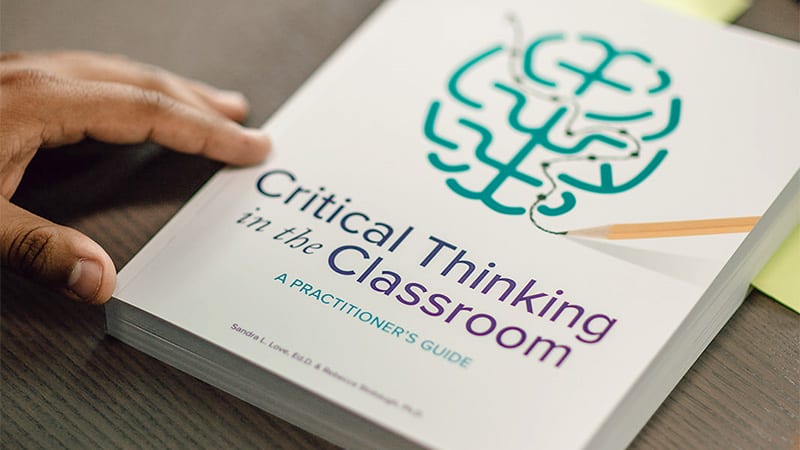
Critical Thinking in the Classroom is a practitioner’s guide that shares the why and the how for building critical thinking skills in K-12 classrooms. It includes over 100 practical tools and strategies that you can try in your classroom tomorrow!
Get Your Copy of Critical Thinking in the Classroom
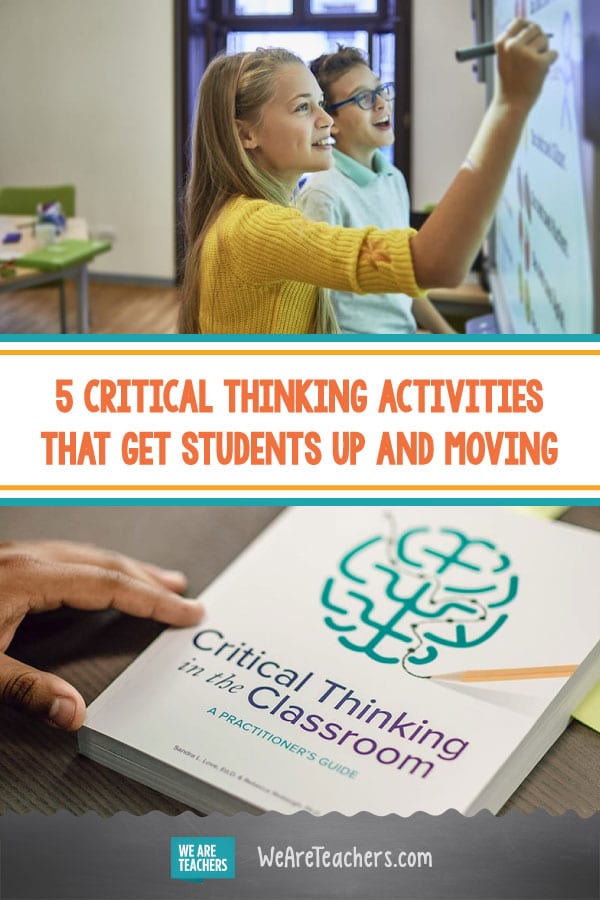
You Might Also Like

10 Tips for Teaching Kids To Be Awesome Critical Thinkers
Help students dig deeper! Continue Reading
Copyright © 2024. All rights reserved. 5335 Gate Parkway, Jacksonville, FL 32256
Critical Thinking Worksheets for Kids
- Printable worksheets
- Educational videos
- Learning games
162 filtered results
- Extra Challenge
- Kindergarten
- Numbers
- Addition & Subtraction
- Measurement
- Multiplication
- Geometry
- Word Problems
- Capitalization
- Punctuation
- 3 Little Pigs
- Holiday Coloring Pages
- Cultures and Holidays Coloring Pages
- Fairy Tale Coloring Pages
- Reading Comprehension
- Rhyming Words
- Building Vocabulary
- Governance and Civics
- Life Science
- Plants and Animals
- The 5 Senses
- Physical Science
- Our Planet and Environment
- Tracing Letters
- Tracing Lines and Curves
- Tracing Numbers
- Tracing Shapes
- Tracing Words
- Cursive Writing
- Color by Numbers
- Connect the Dots
- Fairy Tales
- Problem Solving
- Black history
- Dinosaurs Day
- International Chess Day
- 4th of July
- Thanksgiving
- Alphabet
- Math
- Writing
- Science
- Reading
- Social Studies
- Maze Puzzles
- Connecting the Dots
- English Language Arts
- Critical Thinking
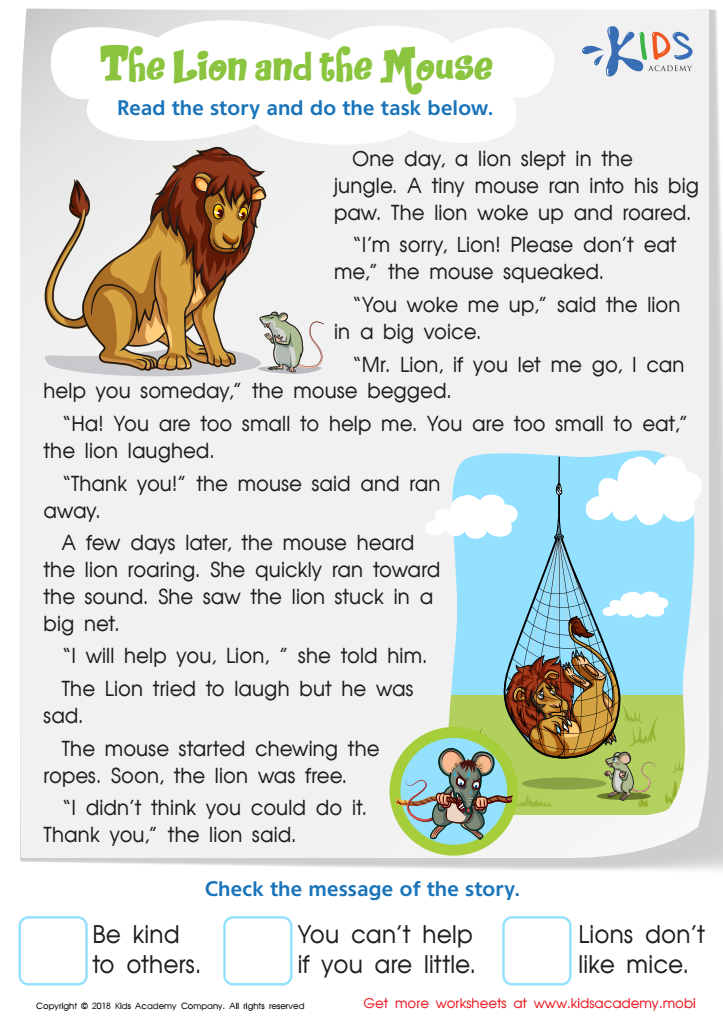
The Lion and the Mouse Worksheet
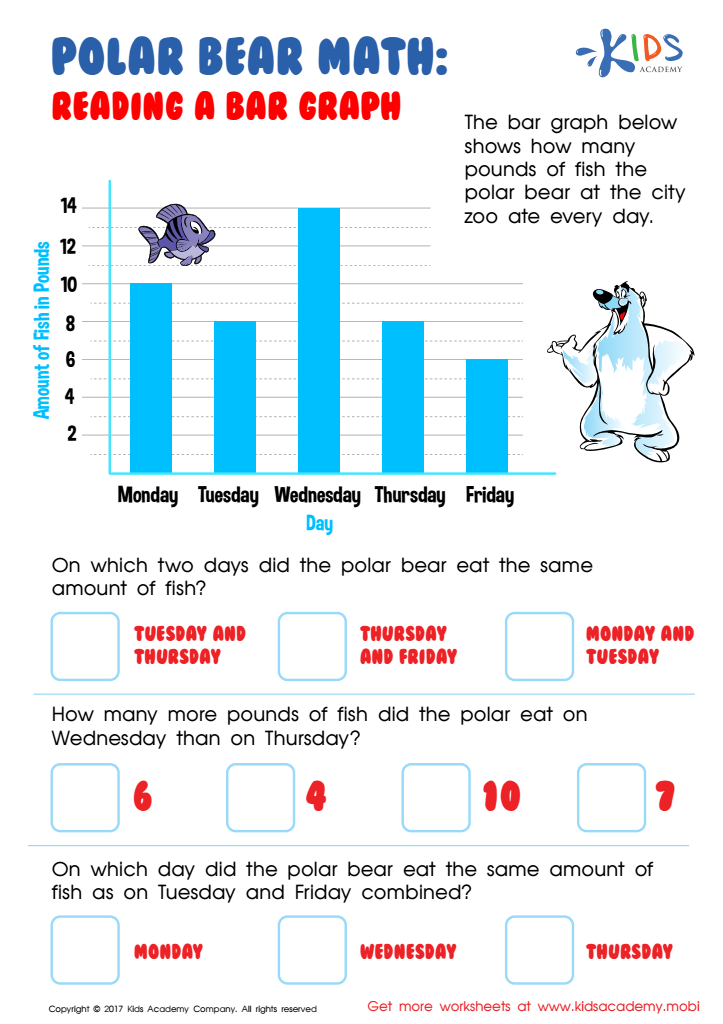
Reading Bar Graph Worksheet
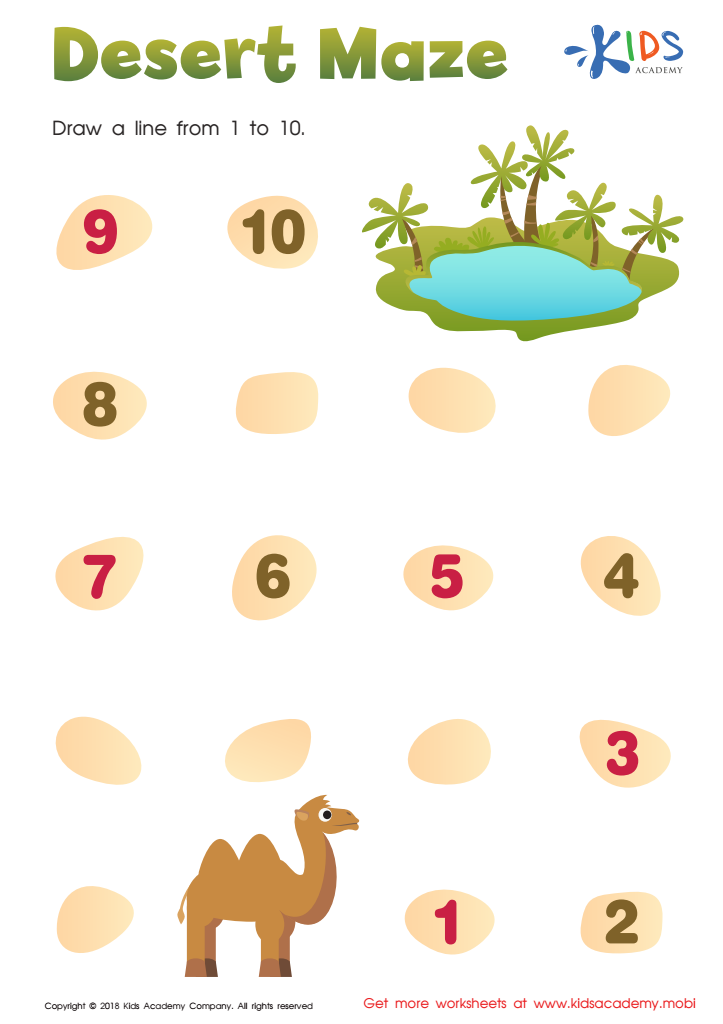
Desert Maze Worksheet
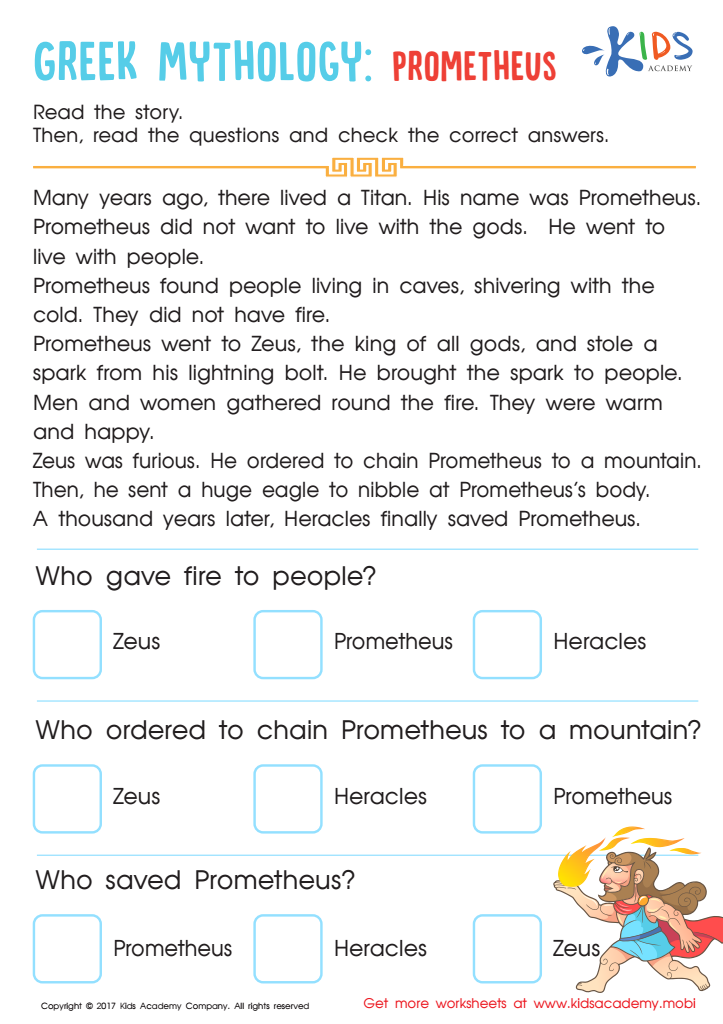
Prometheus Story Worksheet
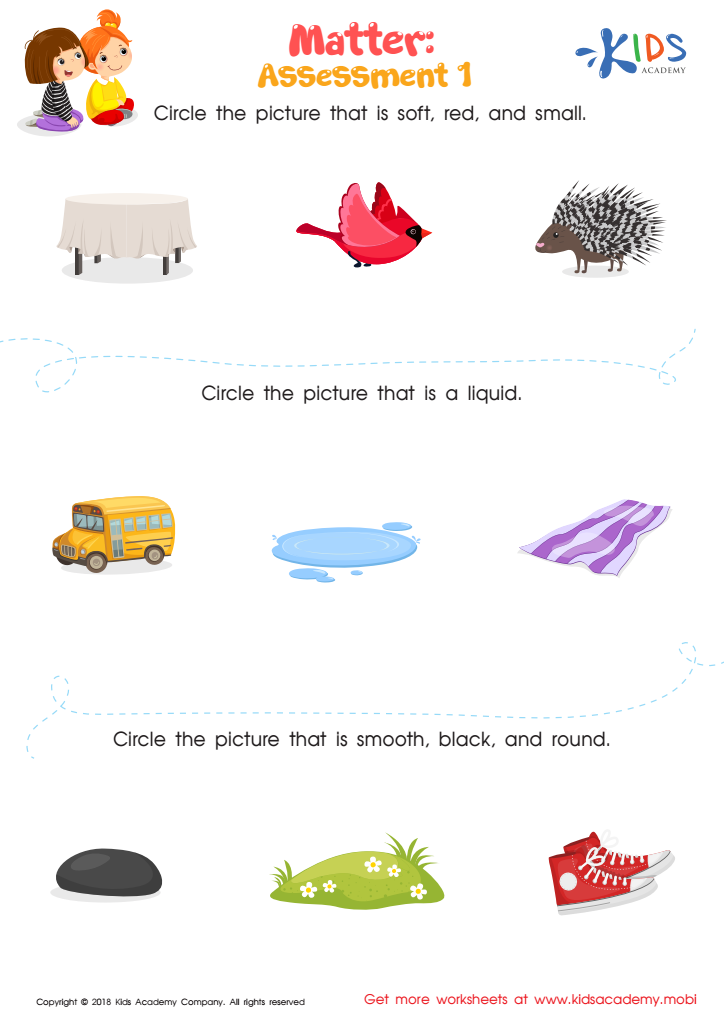
Matter: Assessment 1 Worksheet
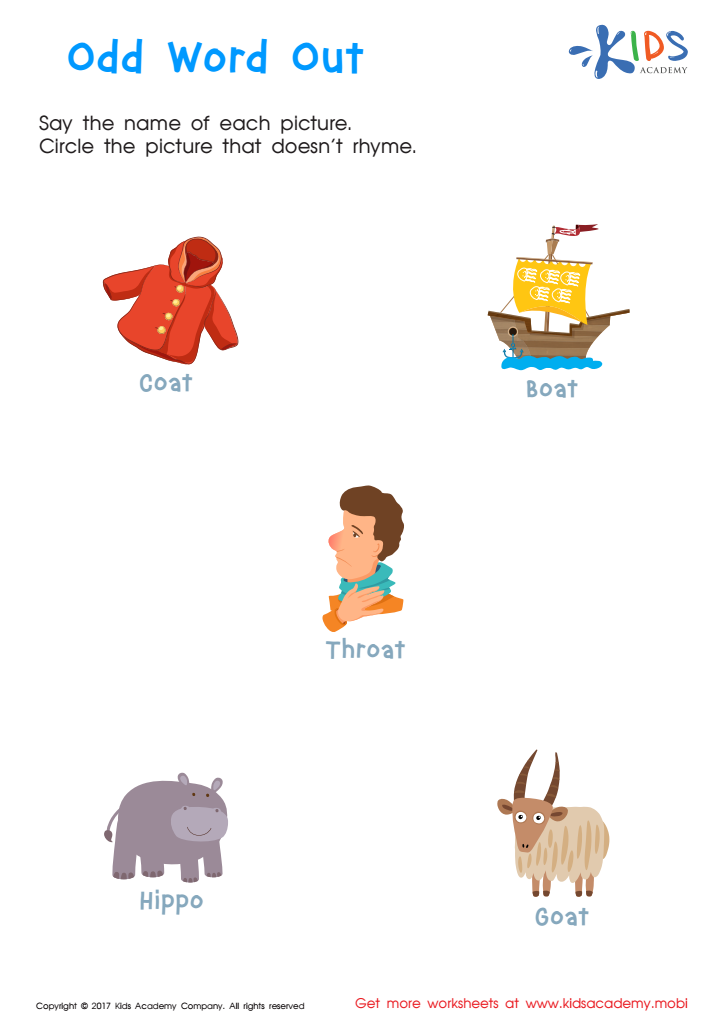
Odd Word Out Rhyming Worksheet
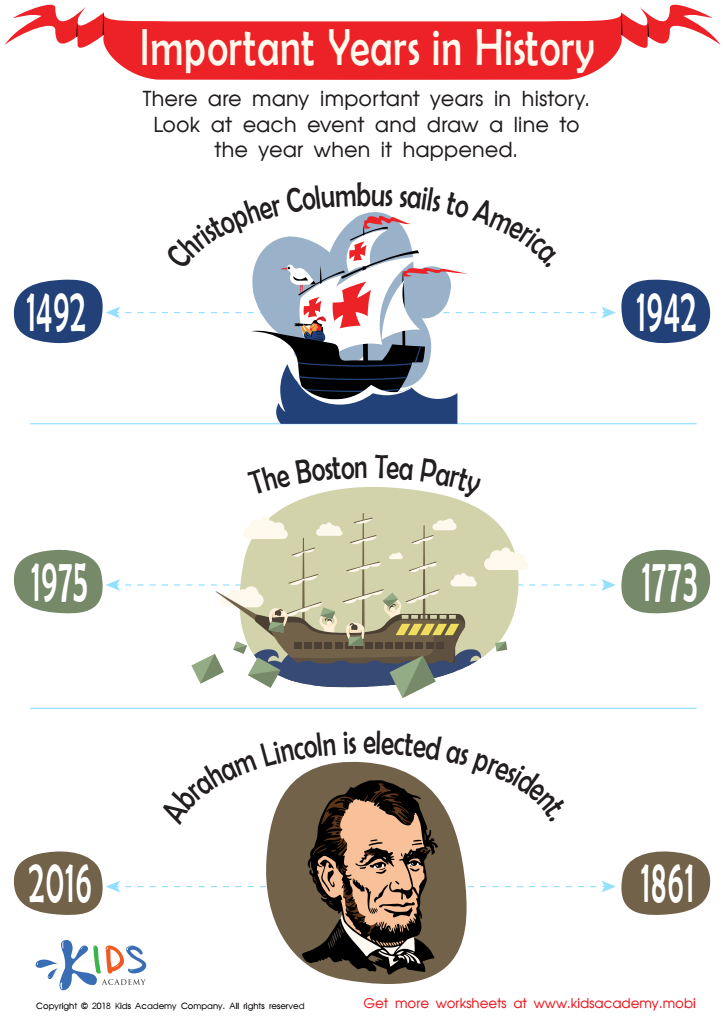
Important Years in History Worksheet
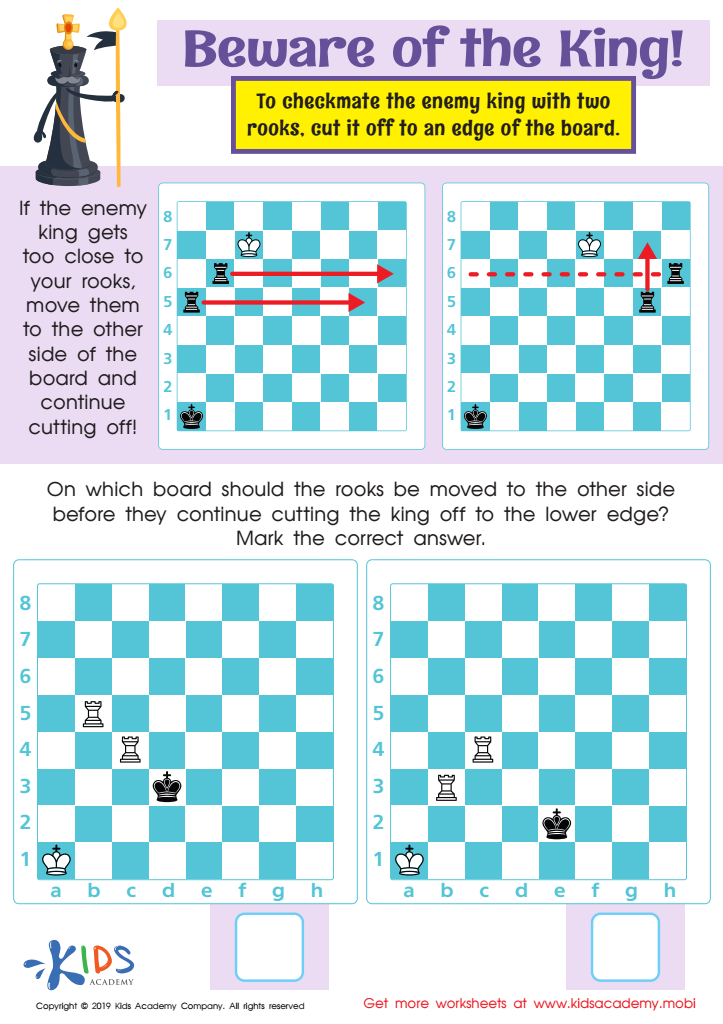
Beware of the King! Worksheet
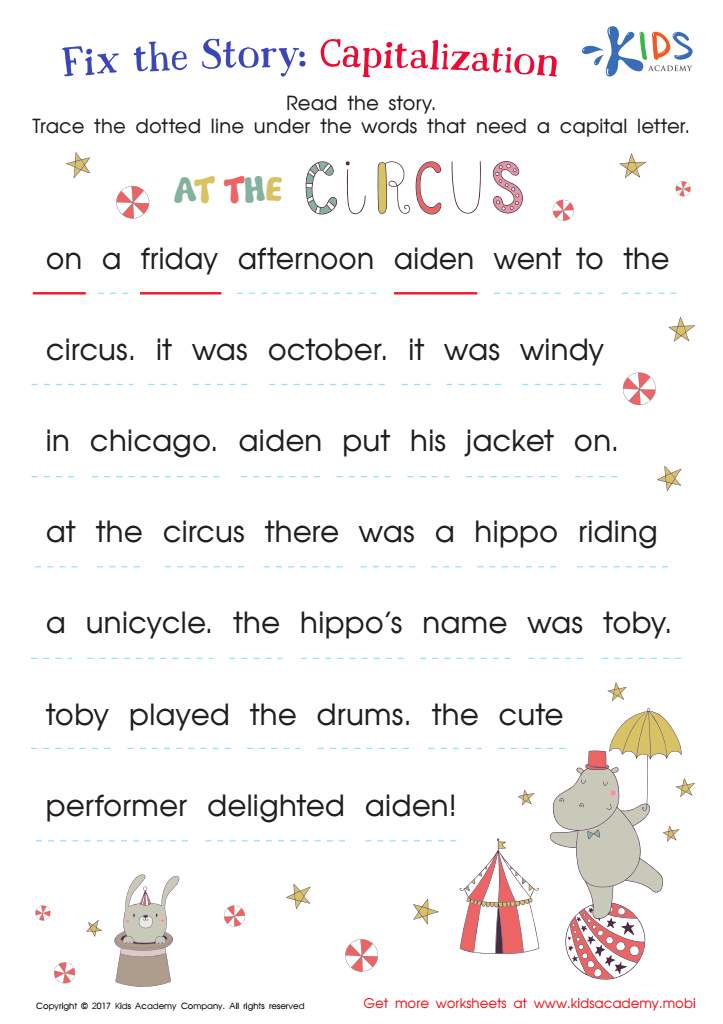
Capitalization: Fix the Story Worksheet
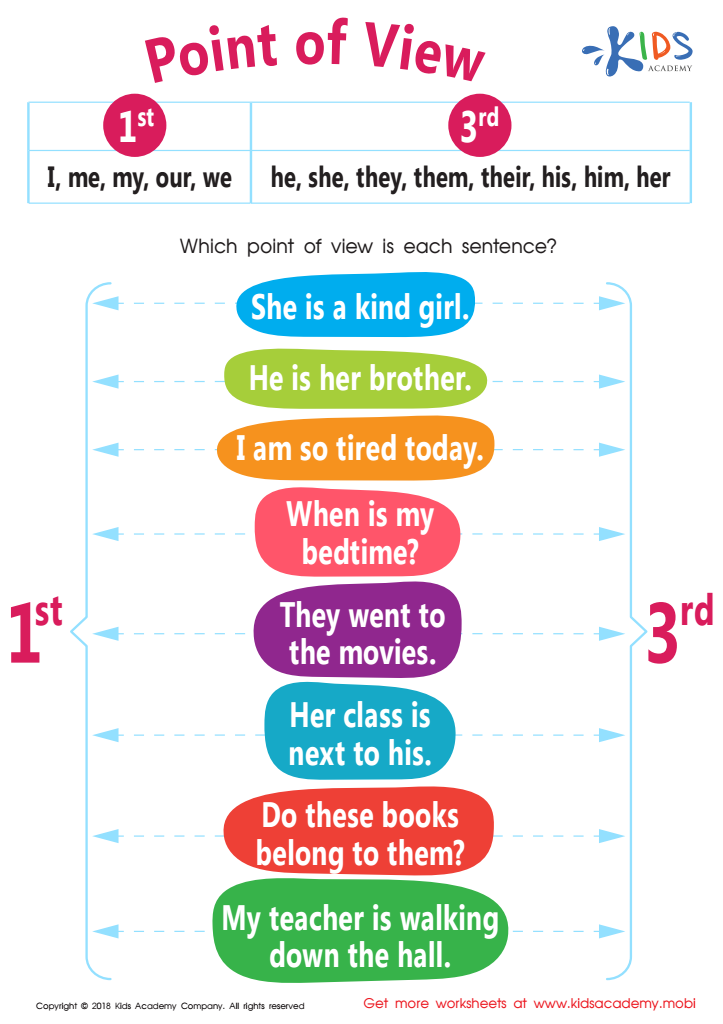
Point of View Worksheet
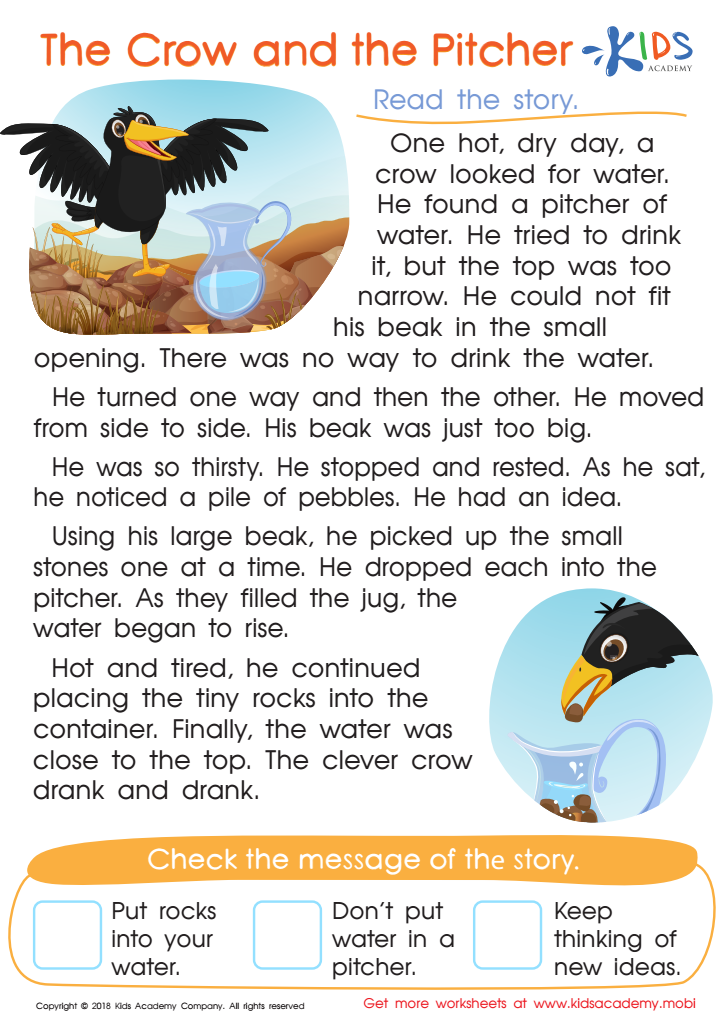
The Crow and the Pitcher Worksheet

Finding the Details and Connections: Assessment 2 Worksheet
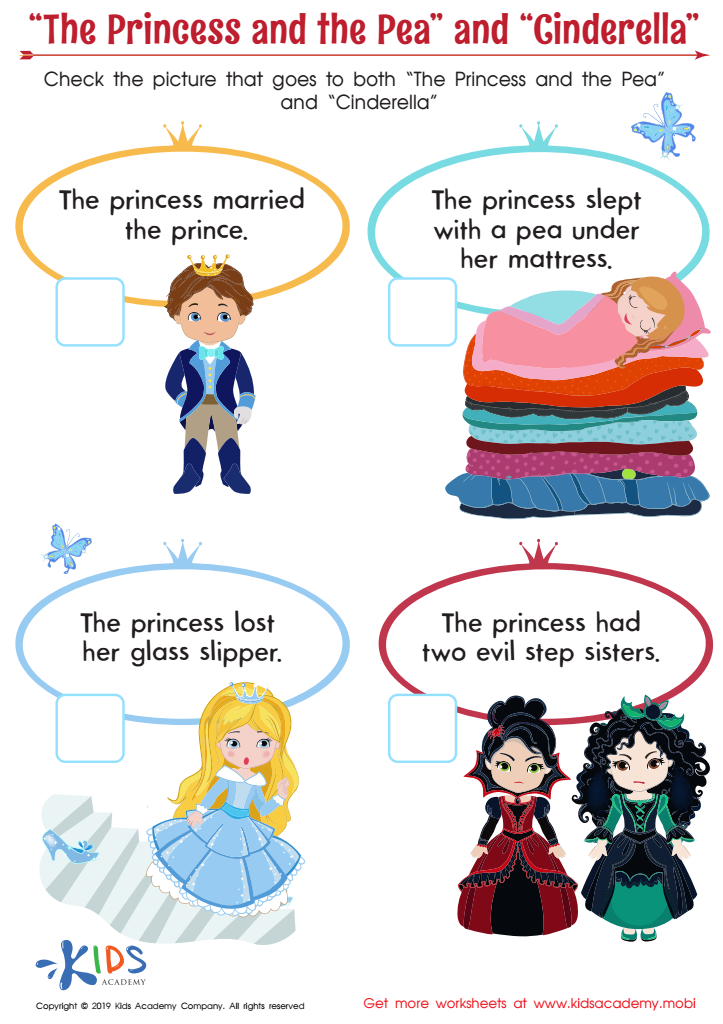
“The Princess and the Pea” and “Cinderella” Worksheet

Amphibians vs Reptiles Worksheet for 3rd Grade
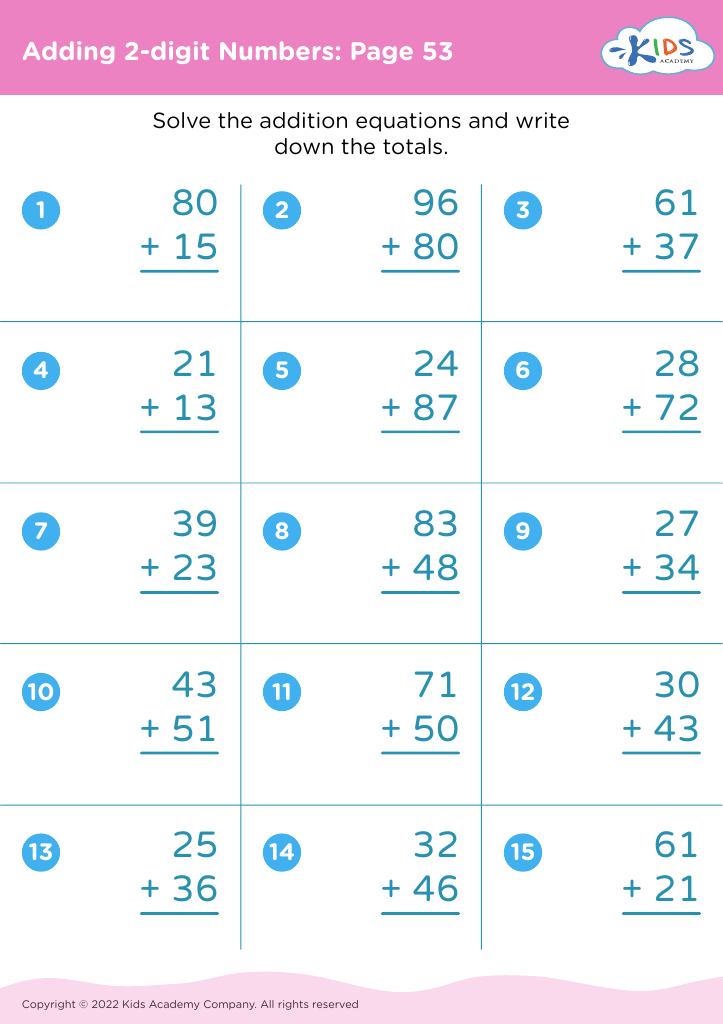
Adding 2-digit Numbers: Page 53
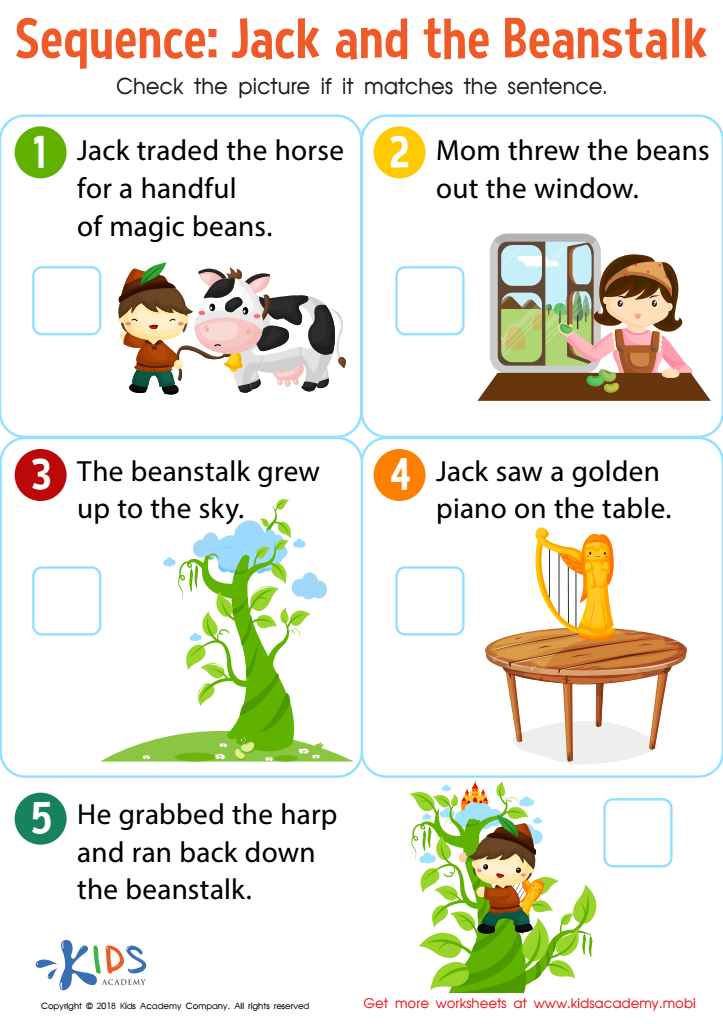
Sequence: Jack and The Beanstalk Worksheet
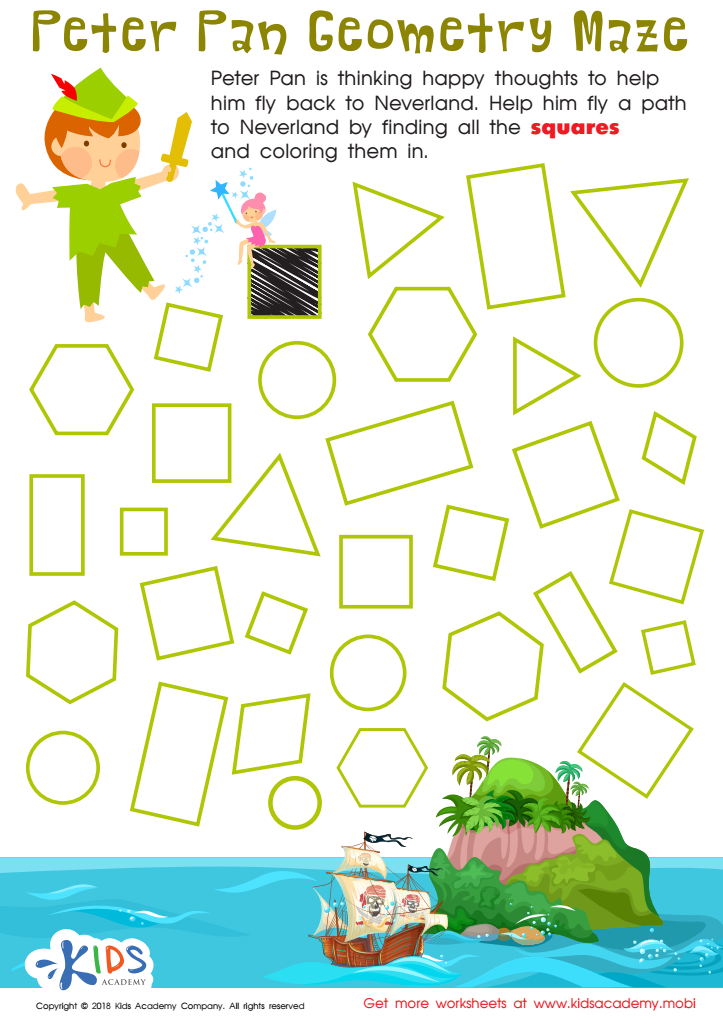
Peter Pan Worksheet
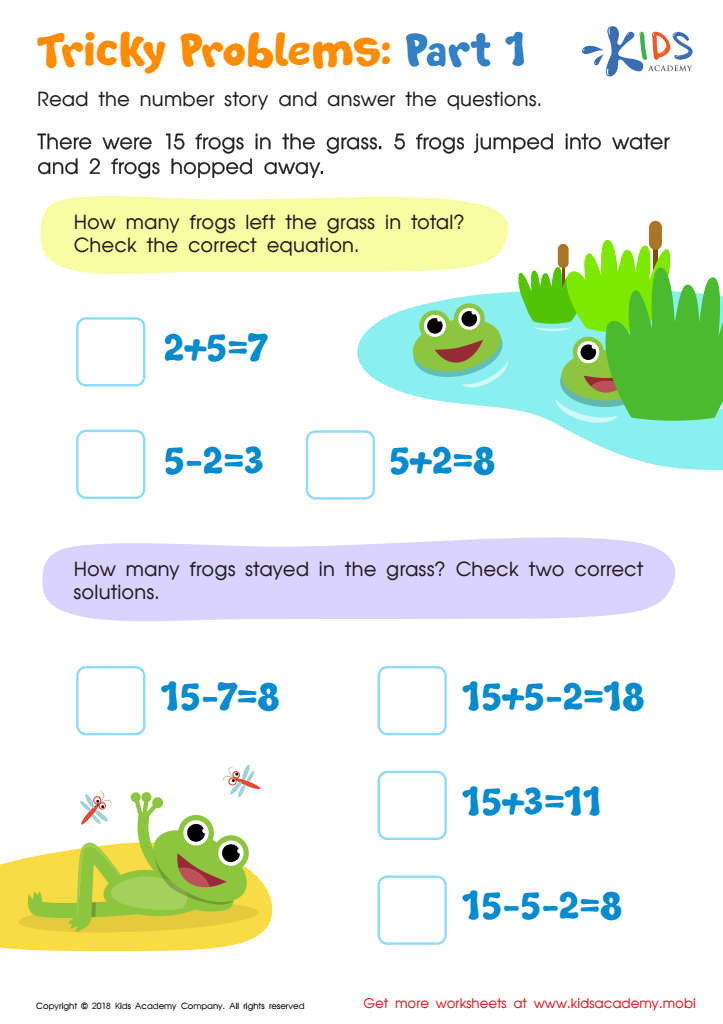
Tricky Problems Worksheet: Part 1
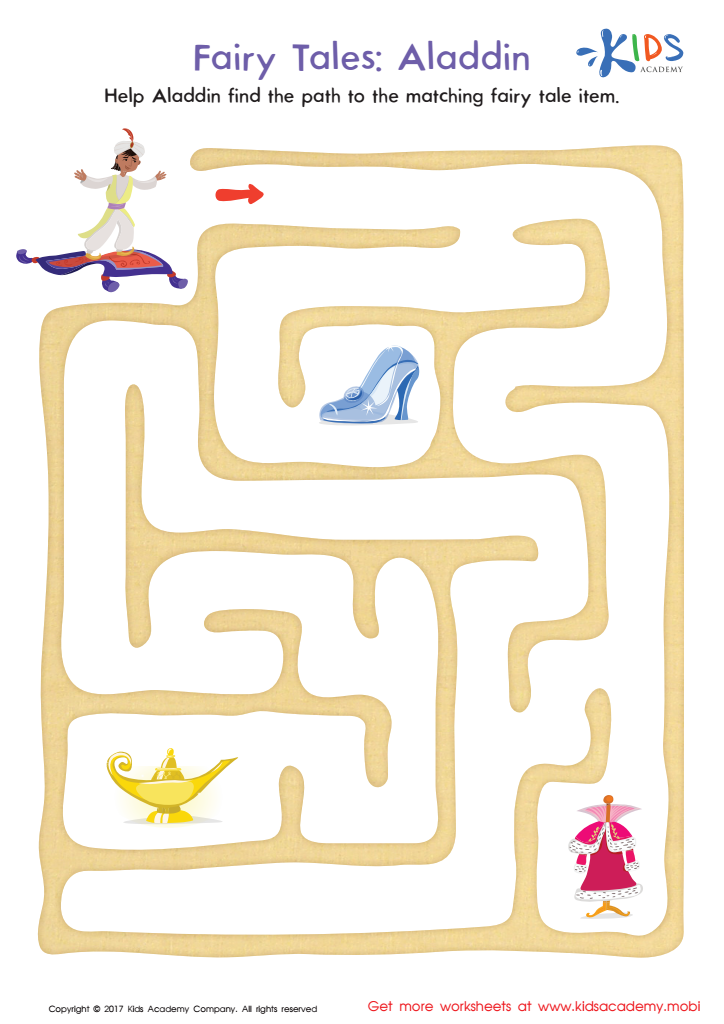
Fairy Tales Aladdin Printable
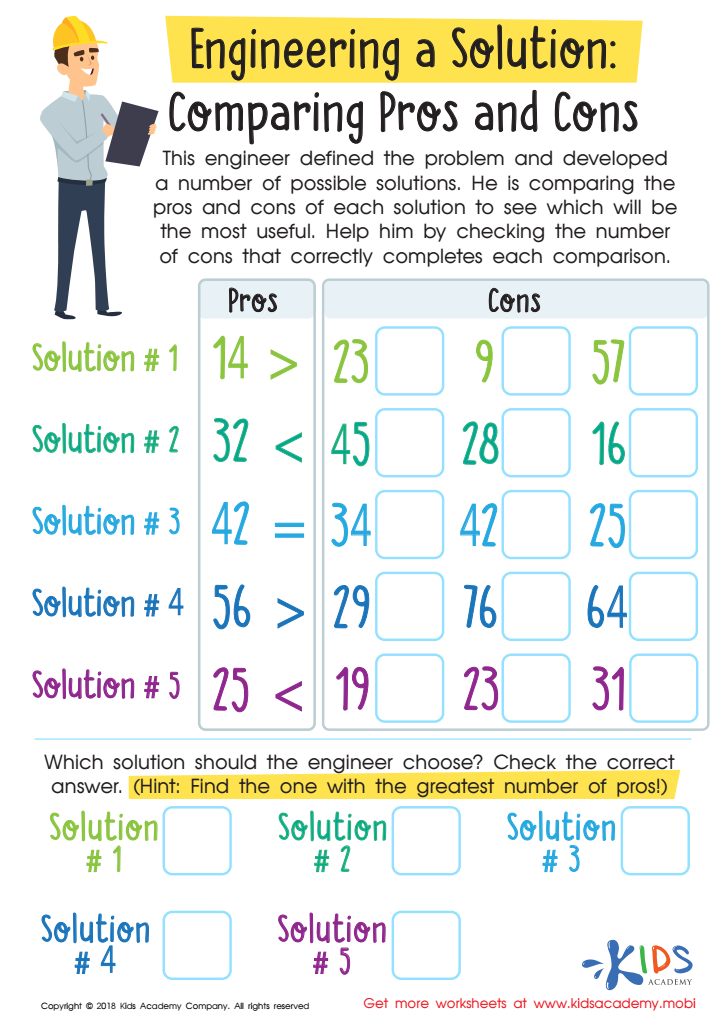
Engineering a Solution: Comparing Pros and Cons Worksheet
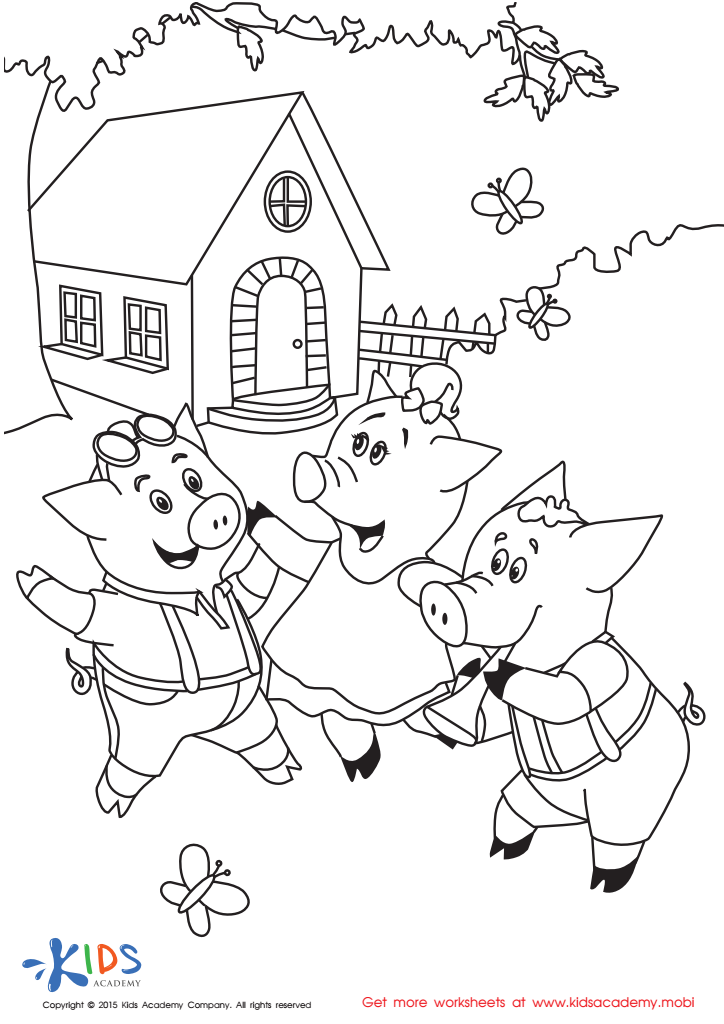
Folktales Printable PDF Worksheet: The 3 Little Pigs
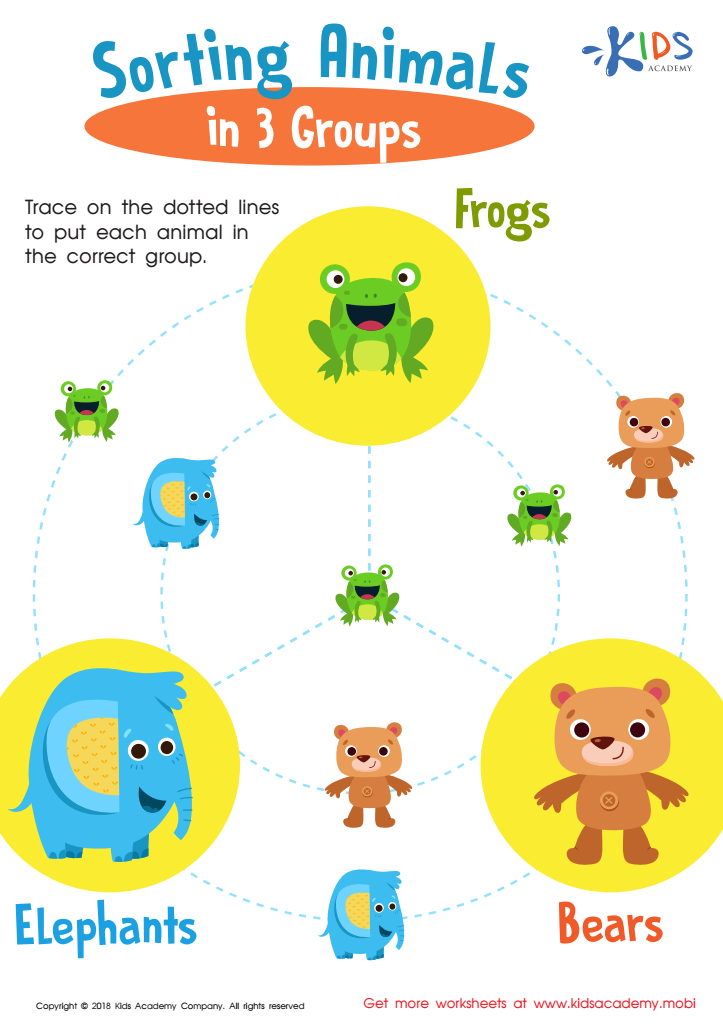
Sorting Animals in 3 Groups Worksheet
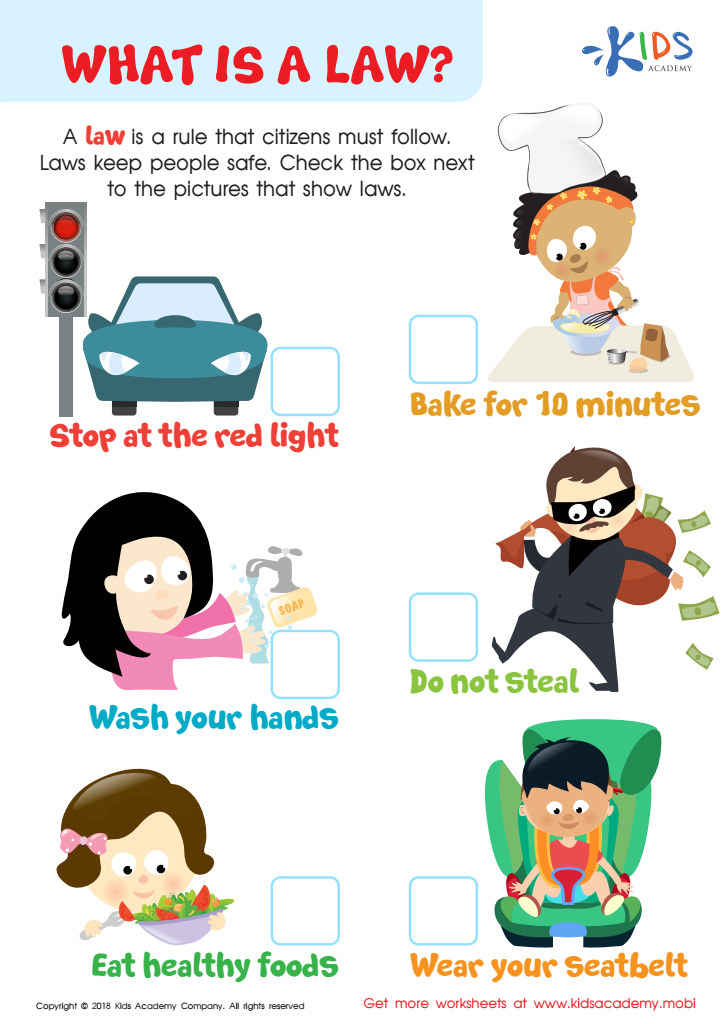
What is a Law? Worksheet
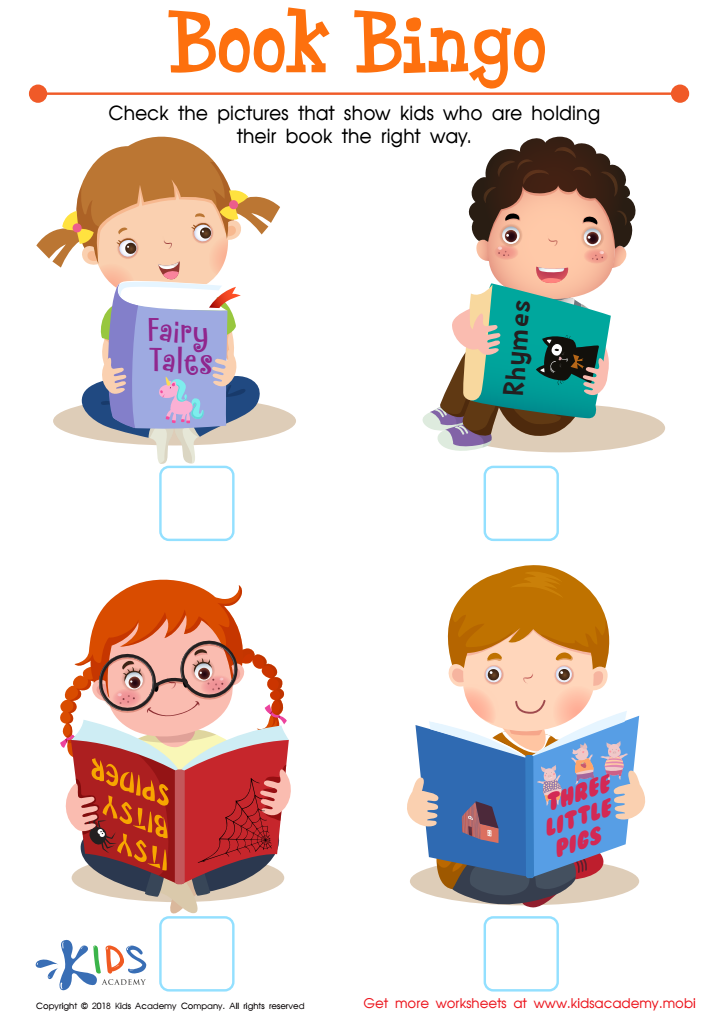
Book Bingo Worksheet
Question/answer, what are some effective activities to train students’ critical thinking skill when teaching them about life science.
Effective activities to train students' Critical Thinking skill in Life Science include: engaging in problem-based learning projects, conducting experiments and analyzing results, debating ethical issues in biology, comparing and contrasting different life processes, and using case studies to apply concepts to real-world scenarios. These activities encourage students to question, analyze, and apply information, enhancing their critical thinking skills.
How does the mastery of the Critical Thinking skill affect a student's performance at an early age?
Mastery of critical thinking at an early age significantly enhances a student's performance by improving problem-solving abilities, fostering independent thinking, and boosting academic success. It enables students to analyze information more effectively, make reasoned judgments, and approach challenges creatively.
Why is the Critical Thinking skill important for Grade 2 students?
Critical thinking is vital for Grade 2 students as it enhances their problem-solving abilities, enabling them to understand complex concepts more deeply. It nurtures their curiosity and creativity, encouraging independent thinking and decision-making. This skill also helps in developing their analytical abilities, making them better at evaluating information, leading to improved academic performance and preparing them for future learning challenges.
Related Articles
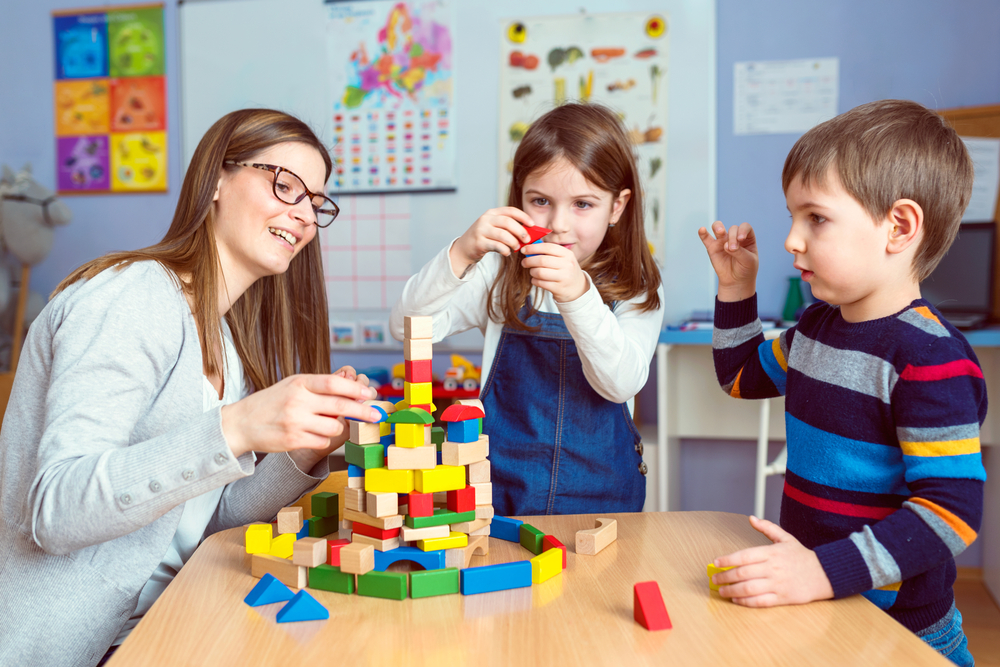
Related Worksheet

You'll be able to manage the favorite spreadsheets list.
You’ll be able to hide/mark the accomplished tasks.
- School / District Account
- Family Account
- 2 PDF worksheets per day
- Interactive worksheets
- Targeted ads
- KidsAcademy ads
$ 1.99 / month
- Printable and interactive worksheets
- Learning videos
- Ad-free browsing
$9.99 / month
- 7000+ online learning activities
- Curriculum created by education experts!
Cancel anytime

Screen Menu

Screen Front Menu
Gced basic search form, quick search, resource type, you are here.
Critical thinking is clear, rational, logical, and independent thinking. It’s about improving thinking by analyzing, assessing, and reconstructing how we think. It also means thinking in a self-regulated and self-corrective manner. It’s thinking on purpose! The Critical Thinking Workbook helps you and your students develop mindful communication and problem-solving skills with exciting games and activities. It has activities that are adaptable to any grade level you want. The activity pages in the Critical Thinking Workbook are meant to be shared and explored. Use it as an electronic document or as worksheets. You can either print off the pages and use them as activity sheets, or you can edit them directly right in the document on your computer. There are also Answer Keys for the activities that need them provided at the back of the book.
Critical Thinking Worksheets
Using the first critical thinking worksheet below, your students will gather evidence about what happened to a missing snack and try to avoid making assumptions.
And in the second critical thinking worksheet, students will evaluate facts based on visual information. Just like a detective, students will look at the available evidence and make conclusions using visuals from our online social and emotional skills game, Zoo U .
We know that making assumptions can be an easy way to fill in missing information, and it’s so easy that sometimes our brain does it automatically. But, making assumptions can have downsides when we let our initial beliefs become the foundation for our thinking about a person or situation. In that case, we need to learn how to apply critical thinking strategies to separate the facts from assumptions.
Bonus: The topic of facts and assumptions is the basis for scene five in our online SEL program, Adventures Aboard the SS GRIN . At the beginning of the scene, students learn that Araella is suspected of stealing the communication stone based on her suspicious behavior. First, students will listen to villagers recount the events of the day and save the notes in a journal. Halfway through the scene, the student will try to determine which of the statements are facts or assumptions. At the end of the scene, the student will present the evidence in court and allow the jury to determine if Araella is guilty. The student should ask questions that allow Araella to share her side of the story to clear up misconceptions.
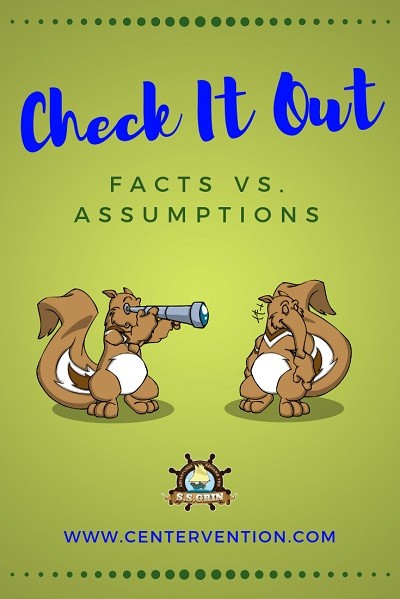
Recommended Grade Level : Elementary and Middle
SEL Skill(s) : Communication
Duration: 30 minutes
Materials: Critical Thinking Worksheet Printable One , Printable Two
Critical Thinking Worksheet Instructions
Explain to your students that just because someone said something, or a situation appears a certain way, doesn’t mean it’s true. A fact is something you know is true and you can prove is true. An assumption is something you think is true, but you might be wrong, or you don’t have enough evidence to prove it’s true.
Imagine this scenario: You usually have apple slices with peanut butter for snack. When you go to your backpack at snack time, your snack is not there. Your classmate, Mike, is eating apple slices with peanut butter for snack today. What happened to your snack?
To figure out what really happened, students will need to think about what’s a fact and what’s an assumption. They will read several statements and check off whether it is a fact that they know is true based on the information they’ve been given, or an assumption that could be true or not true. For example, “The snack was not in my backpack when I went to get it” is a fact, but “someone stole my snack from my bag” is an assumption that they don’t have enough evidence to support.
Making an assumption in this situation could lead to a big argument with Mike, since you’d be accusing him of stealing your snack. Wouldn’t that be embarrassing if you later realized that your Grandma just forgot to pack it?
Additional Resources
- Critical Thinking Detective Book
- The Fallacy Detective: Thirty-Eight Lessons on How to Recognize Bad Reasoning
- The Basics of Critical Thinking
Related Lessons
- Eye Expressions Lesson
- Voice Inflection Lesson
- List of Emotions
Need Something More Engaging And Effective For A Few Students?
Simply request a free centervention educator account and start using our online programs.
Zoo Academy: Grades K-1 Zoo U: Grades 2-4 SS GRIN: Grades 3-5 Hall of Heroes: Middle School Stories in Motion: High Needs
Purchasing Funding Information SEL Spotlight Supplemental Activities
Contact News Research Support
Get in Touch
Tel (919) 283-8899 [email protected]
Copyright 2024 Centervention® | All Rights Reserved | Privacy Policy | Terms of Use

- Productivity
- Thoughtful learning
Become a better critical thinker with these 7 critical thinking exercises

Critical thinking is a skill you can use in any situation. Whether you're a student, entrepreneur, or business executive, critical thinking can help you make better decisions and solve problems.
But learning critical thinking skills isn't always an easy task. Many tools, techniques, and strategies are available, and choosing the right one can be challenging. Vague suggestions on the internet like "read more" aren't very helpful, and elaborate business examples don’t apply to many of us.
As average problem-solvers, we need actionable thinking exercises to improve our critical thinking skills and enhance our thinking processes. Regularly performing exercises that specifically stretch our decision-making and reasoning skills is the most effective method of improving our thinking abilities.
This article will explore several exercises that will help you develop critical thinking skills. Whether you are preparing for an exam, making an influential decision for your business, or going about your daily life, these fun activities can build your reasoning skills and creative problem-solving abilities.
Boost your logical thinking skills and start practicing a critical mindset with these 10 critical thinking exercises.
A Quick Look at Critical Thinking
As a thoughtful learner, you likely already understand the basics of critical thinking, but here's a quick refresher.
Critical thinking involves analyzing problems or issues objectively and rationally. Critical thinkers are able to understand their own biases and assumptions, as well as those of others. They’re also able to see the world from a different point of view and understand how their experiences impact their thinking.
Developing critical thinking skills is essential because it allows us to see things from multiple perspectives, identify biases and errors in reasoning, and be open to possible solutions. Making informed decisions is easier when we have a better understanding of the world around us.
Why We Need to Practice Critical Thinking

We aren't born with critical thinking skills, and they don’t naturally develop beyond survival-level thinking. To master critical thinking, we must practice it and develop it over time.
However, learning to think critically isn't as easy as learning to ride a bicycle. There aren't any step-by-step procedures to follow or supportive guides to fall back on, and it is not taught in public schools consistently or reliably. To ensure students' success, teachers must know higher-order thinking skills (HOTS) and how to teach them, research says.
Unfortunately, although teachers understand the importance of HOTS and attempt to teach it, studies show that their capacity to measure students' HOTS is low. Educator and author Dr. Kulvarn Atwal says, "It seems that we are becoming successful at producing students who are able to jump through hoops and pass tests."
As critical thinking skills become more important in higher grades, some students find it challenging to understand the concept of critical thinking. To develop necessary thinking skills, we must set aside our assumptions and beliefs. This allows us to explore and question topics from a "blank page" point of view and distinguish fact from opinion.

Be the first to try it out!
We're developing ABLE, a powerful tool for building your personal knowledge, capturing information from the web, conducting research, taking notes, and writing content.
7 Critical Thinking Exercises To Improve Your Critical Thinking Skills

The good news is that by assessing, analyzing, and evaluating our thought processes, we can improve our skills. Critical thinking exercises are key to this improvement. Our critical thinking builds and improves with regular practice, just like a muscle that gets stronger with use.
If you want to become a better critical thinker , here are some critical thinking exercises to try:
Exercise #1: The Ladder of Inference
You can exercise your critical thinking skills by using the Ladder of Inference model . This thinking model was developed by renowned organizational psychologist Chris Argyris. Each rung on the ladder of inference represents a step you take to arrive at your conclusions.
The decision-making process starts when we are faced with a problem or situation. As soon as we observe something problematic or important, we presume what is causing it, and then we use that assumption to draw conclusions. Based on those conclusions, we take action.
For example, say you're at a party and see a friend across the room. You catch their eye and wave, but they turn and walk away. Using the ladder, you might climb the rungs as follows:
- Observe that your friend walked away.
- Select a few details of the situation, including your wave and your assumption that they saw you.
- Meaning is attached based on the environment, making you think your friend must have other people to talk to at the party.
- Assumptions are made based on that meaning, assuming that means your friend doesn’t like you as much as them.
- Conclusions are drawn from the assumption, and you determine that your friend must be mad at you or doesn't want you to be at the party.
- Beliefs are formed, making you think you're not welcome.
- Action is taken, and you leave the party.
In this example, you started with a situation (someone walking away at a crowded party) and made a series of inferences to arrive at a conclusion (that the person is mad at you and doesn't want you there).
The Ladder of Inference can be a helpful tool to frame your thinking because it encourages you to examine each step of your thought process and avoid jumping to conclusions. It's easy to make assumptions without realizing it, as in this scene. Perhaps your friend never even saw you wave from across the crowded room.
Exercise #2: The Five Whys
The "Five Whys" technique is an analytical skill that can help you uncover the source of a problem. The activity was created by Sakichi Toyoda, the founder of Toyota, and consists of repeatedly asking “why?” when a problem is encountered to determine its root cause.
This exercise can be difficult because knowing if you've discovered the source of your problem is challenging. The "five" in "Five Whys" is just a guideline — you may need to ask more. When you can't ask anything else, and your response is related to the original issue, you've probably arrived at the end.
Even if you need several rounds of questioning, just keep going. The important part that helps you practice critical thinking is the process of asking "why?" and uncovering the deeper issues affecting the situation.
For instance, say you're trying to figure out why your computer keeps crashing.
- You ask " why ," and the answer is that there's a software problem.
- Why? Because the computer keeps running out of memory.
- Why? Because too many programs are running at the same time.
- Why? Because too many browser tabs are open .
- Why? Because multitasking is fragmenting your focus, you're doing too many things at once.
In this example, working through the "why's" revealed the underlying cause. As a result, you can find the best solution, which is concentrating on just one thing at a time.
Exercise #3: Inversion

Inversion is another critical thinking exercise that you can use in any situation. Inversion is sort of like taking on the role of the devil's advocate. In this exercise, adopt the opposite view of whatever issue you're exploring and consider the potential arguments for that side. This will help broaden your critical thinking skills and enable you to see other perspectives on a situation or topic more clearly.
For example, let's say you're thinking about starting your own business. Using inversion, you would explore all of the potential arguments for why starting your own business is bad. This might include concerns like:
- You could end up in debt.
- The business might fail.
- It's a lot of work.
- You might not have time for anything else.
By exploring these potentially adverse outcomes, you can identify the potential risks involved in starting your own business and make a more sound decision. You might realize that now is not the right time for you to become an entrepreneur. And if you do start the company, you'll be better prepared to deal with the issues you identified when they occur.
Exercise #4: Argument Mapping
Argument mapping can be a beneficial exercise for enhancing critical thinking skills. Like mind mapping, argument mapping is a method of visually representing an argument's structure. It helps analyze and evaluate ideas as well as develop new ones.
In critical thinking textbooks, argument diagramming is often presented to introduce students to argument constructions. It can be an effective way to build mental templates or schema for argument structures, which researchers think may make critical evaluation easier .
Argument maps typically include the following:
- Conclusion: What is being argued for or against
- Premises: The reasons given to support the conclusion
- Inferences: The connections made between the premises and conclusion
The argument map should be as clear and concise as possible, with a single word or phrase representing each element. This will help you make connections more easily. After the map is completed, you can use it to identify any weak points in the argument. If any areas aren't well-supported, additional premises can be added.
Argument mapping can be applied to any situation that requires critical thinking skills. The more time you take to map out an argument, the better you'll understand how the pieces fit together. Ultimately, this will help you think more creatively and critically, and make more informed decisions.
Exercise #5: Opinion vs. Fact
Critical thinking activities that focus on opinions and facts are particularly valuable and relevant new learning opportunities. Our constantly-connected world makes it easy to confuse opinions and facts , especially with sensationalist news articles and click-bait headlines.
How can you tell a fact from an opinion? Facts are generally objective and established, whereas opinions are subjective and unproven. For example, "the cloud is in the air" is a fact. "That dress looks good on you" is an opinion.
Practice your critical thinking skills by reading or listening to the news. See if you can identify when someone is stating an opinion rather than a fact. Ask yourself the following questions:
- Who is saying what? What reasons might be behind their statements?
- Does the claim make sense? Who would disagree with it and why?
- How can you tell if the data is reliable? Can it be fact-checked? Has it been shared by other credible publishers?
- How do you know whether or not the presenter is biased? What kind of language is being used?
This powerful exercise can train your mind to start asking questions whenever presented with a new claim. This will help you think critically about the information you're taking in and question what you're hearing before accepting it as truth.
Exercise #6: Autonomy of an Object
In her book " The Critical Thinking Tool Kit ," Dr. Marlene Caroselli describes a critical thinking exercise called "Living Problems, Lively Solutions." This exercise uses the autonomy of an object as a problem-solving tool to find a possible solution.
To do this, you'll personify your problem and place it in another context — a different time or place. This allows you to uncover unique solutions to the problem that might be tied to your mental associations with that setting.
For example, if your problem is poor time management , you might personify the issue as a thief of your time. The idea of a thief could make you think of jail, which might prompt thoughts of locking up specific distractions in your life. The idea of jail could also make you think of guards and lead you to the possible solution of checking in with an accountability buddy who can make sure you're sticking to your schedule.
The autonomy-of-object technique works because it stimulates thoughts you wouldn’t have considered without the particular context in which you place the problem.
Exercise #7: The Six Thinking Hats

Designed by Edward de Bono, the Six Thinking Hats is a critical thinking exercise that was created as a tool for groups to use when exploring different perspectives on an issue. When people use other thinking processes, meetings can become challenging rather than beneficial.
To help teams work more productively and mindfully, de Bono suggests dividing up different styles of thinking into six categories, represented as hats:
- The white hat is objective and focuses on facts and logic
- The red hat is intuitive, focusing on emotion and instinct
- The black hat is cautious and predicts negative outcomes
- The yellow hat is optimistic and encourages positive outcomes
- The green hat is creative, with numerous ideas and little criticism
- The blue hat is the control hat used for management and organization
With each team member wearing a different hat, a group can examine an issue or problem from many different angles, preventing one viewpoint (or individual) from dominating the meeting or discussion. This means that decisions and solutions reached using the Six Thinking Hats approach will likely be more robust and effective, and everyone’s creative thinking skills will benefit.
Train Your Brain With Critical Thinking Exercises
Using critical thinking regularly in various situations can improve our ability to evaluate and analyze information. These seven critical thinking exercises train your brain for better critical thinking skills . With daily practice, they can become habits that will help you think more critically each day.
Improve your critical thinking with ABLE
Ask better questions and get better answers with ABLEs integrated web search, annotation and note-taking features. Check how ABLE helps you to improve your critical thinking.
I hope you have enjoyed reading this article. Feel free to share, recommend and connect 🙏
Connect with me on Twitter 👉 https://twitter.com/iamborisv
And follow Able's journey on Twitter: https://twitter.com/meet_able
And subscribe to our newsletter to read more valuable articles before it gets published on our blog.
Now we're building a Discord community of like-minded people, and we would be honoured and delighted to see you there.

Straight from the ABLE team: how we work and what we build. Thoughts, learnings, notes, experiences and what really matters.
Read more posts by this author
follow me :
Mental models: 13 thinking tools to boost your problem-solving skills
7 note-taking strategies to improve your study skills.

What is abstract thinking? 10 activities to improve your abstract thinking skills

5 examples of cognitive learning theory (and how you can use them)
0 results found.
- Aegis Alpha SA
- We build in public
Building with passion in
- Number Chart
- Number Counting
- Skip Counting
- Tracing – Number Tracing
- Numbers – Missing
- Numbers – Least to Greatest
- Before & After Numbers
- Greater & Smaller Number
- Number – More or Less
- Numbers -Fact Family
- Numbers – Place Value
- Even & Odd
- Tally Marks
- Fraction Addition
- Fraction Circles
- Fraction Model
- Fraction Subtraction
- Fractions – Comparing
- Fractions – Equivalent
- Decimal Addition
- Decimal Model
- Decimal Subtraction
- Addition – Picture
- Addition – 1 Digit
- Addition – 2 Digit
- Addition – 3 Digit
- Addition – 4 Digit
- Addition – Missing Addend
- Addition Regrouping
- Addition Word Problems
- Subtraction – Picture
- Subtraction – 1 Digit
- Subtraction – 2 Digit
- Subtraction – 3 Digit
- Subtraction – 4 Digit
- Subtraction Regrouping
- Multiplication – Repeated Addition
- Times Tables
- Times Table – Times Table Chart
- Multiplication – Horizontal
- Multiplication – Vertical
- Multiplication-1 Digit
- Multiplication-2 Digit by 2 Digit
- Multiplication-3 Digit by 1 Digit
- Squares – Perfect Squares
- Multiplication Word Problems
- Square Root
- Division – Long Division
- Division-2Digit by1Digit-No Remainder
- Division-2Digit by1Digit-With Remainder
- Division-3Digit by1Digit-No Remainder
- Division – Sharing
- Time – Elapsed Time
- Time – Clock Face
- Pan Balance Problems
- Algebraic Reasoning
- Math Worksheets on Graph Paper
- Preschool Worksheets
- Kindergarten Worksheets
- Home Preschool Kindergarten First Grade Math Pinterest
- Book Report Critical Thinking Pattern Cut and Paste Patterns Pattern – Number Patterns Pattern – Shape Patterns Pattern – Line Patterns Easter Feelings & Emotions Grades Fifth Grade First Grade First Grade – Popular First Grade Fractions Fourth Grade Kindergarten Worksheets Kindergarten Addition Kindergarten Subtraction PreK Worksheets Preschool Worksheets Color, Trace & Draw Coloring Color by Number Spring Cut and Paste Activities Cut and Paste Letters Cut and Paste Numbers Cut and Paste Shapes Cut and Paste Worksheets Dot to Dot Dot to Dot – Numbers 1-10 Dot to Dot – Numbers 1-20 Dot to Dot – Tracing Dot to Dot – Letter – a-z Dot to Dot – Numbers 1-50 Fruits and Vegetables Modes of Transportation Opposites Preschool Matching Worksheets Scissor Cutting Skills Size – Same and Different Size Comparison Size – Big Bigger Biggest Size – Longest and Shortest Size – Shortest and Tallest Size – Smallest and Biggest Tracing Pre Writing Worksheets Tracing – Line Tracing – Preschool Tracing – Shape Tracing – Preschool Tracing – Picture Tracing Tracing – Picture Tracing – Popular Trace and Draw Tracing – Spiral Tracing Second Grade Second Grade – Popular Third Grade Graphing Graph – Trace and Draw Graphing – Count and Graph Halloween Worksheets Pumpkin Worksheets Letter Alphabet Coloring Letter – Coloring Letter – Mazes Letters – Alphabet Chart Letters – Before and After Letters – Capital Letters Letters -Uppercase Letters Letters – Uppercase and Lowercase Letters -Missing Letters Letters -Small Letters Letters -Lowercase Letters Tracing – Letter Tracing Uppercase and Lowercase Math Addition Addition – 1 Digit Addition – 1 More Addition – 10 more Addition – 2 Digit Addition – 3 Digit Addition – 4 Digit Addition – Add and Match Addition – Add and Multiply Addition – Add Tens Addition – Adding 3 Numbers Addition – Adding 4 Numbers Addition – Basic Addition Facts Addition – Dice Addition – Making 10 Addition – Making 5 Addition – Missing Addend Addition – No Regrouping Addition – Number Line Addition – Picture Addition – Popular Addition – Repeated Addition Addition – Sums up to 10 Addition – Sums up to 20 Addition – Sums up to 30 Addition – Ways to Make a Number Addition – Sums up to 5 Addition Doubles Addition Doubles Plus One Addition Regrouping Addition Sentences Addition/Subtraction Addition/Subtraction – 1 More 1 Less Addition/Subtraction – 10 More 10 Less Algebra Algebraic Reasoning Balancing Equations Equations Pan Balance Problems Brain Teasers Decimal Decimal Addition Decimal Model Decimal Subtraction Dice Worksheets Division Division – Long Division Division – Sharing Division-2Digit by1Digit-No Remainder Division-2Digit by1Digit-With Remainder Division-3Digit by1Digit-No Remainder Fraction Fraction Addition Fraction Circles Fraction Circles Template Fraction Model Fraction Subtraction Fractions – Coloring Fractions – Comparing Fractions – Equivalent Fractions – Halves Geometry Polygon Magic Squares Magic Triangles Math Worksheets on Graph Paper Multiplication Multiplication – Basic Facts Multiplication – Cubes Multiplication – Horizontal Multiplication – Popular Multiplication – Quiz Multiplication – Repeated Addition Multiplication – Test Multiplication – Vertical Multiplication Target Circles Multiplication-1 Digit Multiplication-2 Digit by 2 Digit Multiplication-3 Digit by 1 Digit Multiplication-3 Digit by 2 Digit Squares – Perfect Squares Times Tables Times Table – 10 Times Table Times Table – 11 Times Table Times Table – 12 Times Table Times Table – 2 Times Table Times Table – 3 Times Table Times Table – 4 Times Table Times Table – 5 Times Table Times Table – 6 Times Table Times Table – 7 Times Table Times Table – 8 Times Table Times Table – 9 Times Table Times Table – Popular Times Table – Times Table Chart Times Tables – Advanced Times Tables 2 -12 – 1 Worksheet Number Number – Comparing Number – More or Less Number – Greater & Smaller Number – Hundreds Number – Ordinal Numbers Number Bonds Number Chart Number Coloring Number Counting Number – Count How Many Number Counting – Dice Numbers – Count and Match Numbers – Before, After, and Between Numbers 1-20 – Before & After Numbers – Even & Odd Numbers – Missing Numbers – Missing Numbers 1-50 Numbers – Missing Numbers 1-10 Numbers – Missing Numbers 1-100 Numbers – Missing Numbers 1-15 Numbers – Missing Numbers 1-20 Numbers – Missing Numbers 1-30 Numbers – Ordering Numbers Numbers – Least to Greatest Numbers – Ordering Numbers 1-10 Numbers – Ordering Numbers 1-100 Numbers – Ordering Numbers 1-20 Numbers – Ordering Numbers 1-30 Numbers – Ordering Numbers 1-50 Numbers – Place Value Numbers – Ten Frames Numbers – Tens and Ones Numbers -Fact Family Numbers 1 – 10 Numbers 1 – 100 Numbers 1 – 20 Numbers 1 – 30 Numbers 1 – 50 Numbers 1 – 15 Numbers 1-120 Part Part Whole Skip Counting Skip Counting – Count by 1000s Skip Counting – Count by 100s Skip Counting – Count by 10s Skip Counting – Count by 2s Skip Counting – Count by 5s Skip Counting – Popular Skip Counting by 2s, 5s, and10s Tracing – Number Tracing Percent Puzzles Regrouping – Addition and Subtraction Shapes Shape – Match Shapes Shape – Mazes Shape Names Shapes – Popular Square Root Subtraction Subtraction – 1 Digit Subtraction – 1 Less Subtraction – 10 Less Subtraction – 2 Digit Subtraction – 3 Digit Subtraction – 4 Digit Subtraction – Missing Minuends Subtraction – Missing Subtrahends Subtraction – No Regrouping Subtraction – Number Line Subtraction – Picture Subtraction – Subtract and Match Subtraction – Subtract Tens Subtraction – Within 10 Subtraction – Within 20 Subtraction – Within 5 Subtraction Regrouping Subtraction Sentences Symmetry Tally Marks Time Time – Clock Face Time – Draw the hands Time – Elapsed Time Time – Elapsed Time Ruler Time – Telling Time Word Problems Addition Word Problems Multiplication Word Problems Subtraction Word Problems Missing Operator Most Popular Math Worksheets Most Popular Preschool and Kindergarten Worksheets Most Popular Worksheets New Worksheets Phonics Phonics – Beginning Sounds Phonics – Ending Sounds Phonics – Middle Sounds Preschool and Kindergarten – Mazes Printable Posters Charts Science Life Cycle Spelling Spelling – Days of the Week Spelling – Months of the Year Spelling – Numbers in Words Spot the difference Theme Worksheets Theme – Animal Theme – Dinosaur Theme – Cloud Theme – Flower Theme – Fruit Theme – Transport Theme – Aeroplane Theme – Car Theme – Rocket Theme – Train Theme – Truck Thinking Skills Analogies Worksheets Picture Analogies Preschool – Connect other half Top Worksheets Uncategorized Writing

Picture Analogies – One Worksheet
- brain teasers
- challenge problems
- cognitive skills
- critical thinking
- critical thinking exercises
- critical thinking worksheet
- critical thinking worksheets
- find the relationship
- Free Printable Picture Analogy Worksheets
- kindergarten
- logical reasoning
- nursery school
- picture analogies
- picture analogy
- Picture Analogy Worksheets
- pre kindergarten
- PreKindergarten
- preschool printables
- preschool worksheet
- Preschool worksheets
- thinking skill
Shapes Pattern – One Worksheet
- Complete the Shape Pattern
- Find the Pattern
- Finding Pattern
- Kindergarten Worksheets
- Learning Pattern
- Pattern Recognition
- Pattern Recognition Worksheets
- Patterns Worksheets
- Patterns Worksheets and Printables
- PreK Worksheets
- Preschool – Shapes
- recognition
- Shapes Pattern
- Shapes Pattern Recognition
- Understand Visual Patterns
- what comes next
- What Shape Comes Next
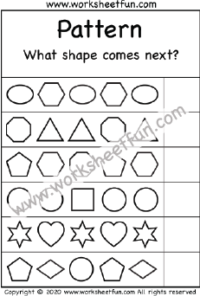
- Preschool - Shapes
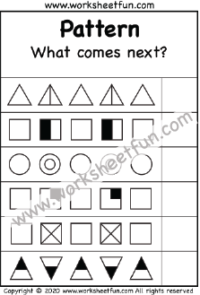
Pattern – What comes next? – One Worksheet
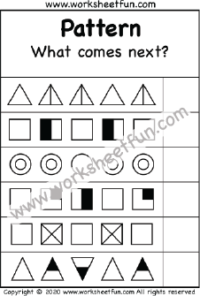
Cut and Paste Patterns – One Worksheet
- Cut and Glue
- Cut and Paste
- Cut and paste patterns
- pattern worksheets
- Patterns Cut And Paste
- Patterns Cut And Paste Worksheets
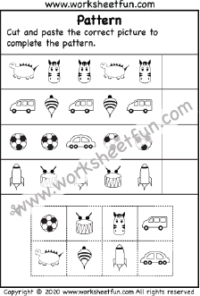
Shape Patterns – Cut and Paste – One Worksheet
- Cut and paste shape patterns
- Shape Patterns
- Shape Patterns Cut And Paste
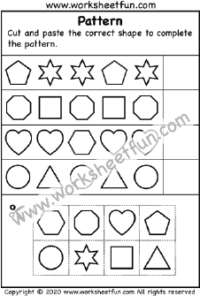
Spot the difference – Spider – One Worksheet
- between two similar photos
- brain warmed up
- concentration
- differences
- find difference
- find difference pictures
- Find the differences
- find the differences between the two pictures
- find the same worksheet for nursery
- free preschool worksheets
- Identify the differences
- Identify the differences between two similar photos
- Kindergarten Learning Worksheets
- observational skills
- printable spot
- printable spot difference
- same and different worksheet for nursery
- same and different worksheets for grade 1
- searching for the differences
- spot difference
- spot difference puzzles
- spot the difference
- spot the difference for kids
- Spot the difference is a type of puzzle
- spot the difference printable
- spot the differences
- teaching same and different kindergarten
- the difference
- what is different worksheets
- worksheet for preschool
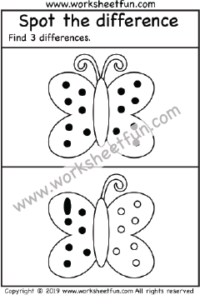
Spot the difference – Butterfly – One Worksheet
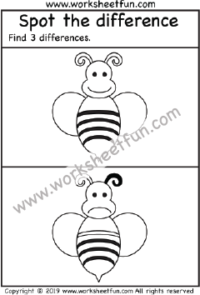
Spot the difference – Bee – One Worksheet
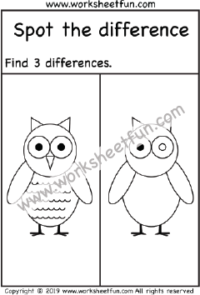
Spot the difference – Owl – One Worksheet
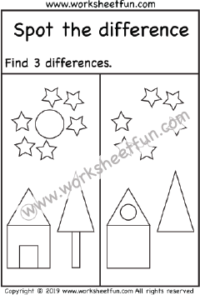
Spot the difference – One Worksheet
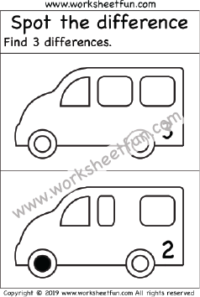
Spot the difference – Van – One Worksheet
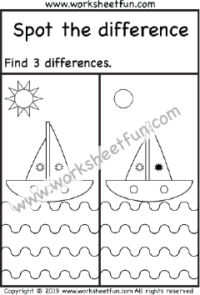
Spot the difference – Girl – One Worksheet
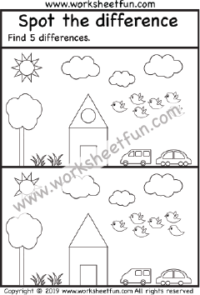
Loading …
Scroll to Top
- Skip to primary navigation
- Skip to main content
- Skip to primary sidebar
- Skip to footer
KidsKonnect
Reading Comprehension Cause and Effect Context Clues Compare and Contrast
Noun Worksheets Writing Prompts Compound Words Figurative Language
The Wizard of Oz Hans Christian Andersen Types of Writing Text Structure
Literary Devices
Alliteration Hyperbole Metaphor Irony
Subject Verb Agreement Poetry Climax Rhyme
View all reading worksheets
Action Verbs Tragedy Transition Words Phonics
View all writing worksheets
Dramatic Irony Cacophony Anaphora Setting
View all literature worksheets
Abbreviations Transition Words Conclusion Situational Irony
View all literary device worksheets
Women’s History
Inspirational Women Women's History Month First Lady of the US Women's Equality Day International Women's Day
View all Women's History worksheets
American Revolution
American Revolution Patriots & Loyalists Patrick Henry Sons of Liberty
View all American Revolution worksheets
US Constitution US Independence Trail of Tears The Pilgrims
View all US History worksheets
Ancient History
Ancient China Ancient Mayan Ancient Rome Ancient Aztec
View all Ancient History worksheets
World History
Roaring Twenties Industrial Revolution Middle Ages The Renaissance
View all World History worksheets
Famous Wars
World War 1 World War 2 Vietnam War American Civil War
View all Famous War worksheets
Anne Frank Sally Ride Neil Armstrong Christopher Columbus
View all famous figure worksheets
Joe Biden Donald Trump Abraham Lincoln George Washington
View all President worksheets
Roald Dahl Dr Seuss JK Rowling Michael Morpurgo
View all author worksheets
Civil Rights
Rosa Parks Sojourner Truth Medger Evers Martin Luther King
Elvis Presley Johann Sebastian Bach Ella Fitzgerald Wolfgang Mozart
View all musician worksheets
Thomas Edison Albert Einstein Henry Ford Wright Brothers
View all inventor worksheets
Muhammad Ali Michael Jordan Jackie Robinson Jesse Owens
View all athlete worksheets
Nat Turner Ruby Bridges Harriet Tubman Booker T Washington Malcolm X
View all civil rights worksheets
Natural Wonders
River Nile Mount Everest Sahara Desert Mount Etna Ancient Pyramids Amazon River

Landmarks/Sights
Mount Rushmore Statue Of Liberty White House Stonehenge Great Wall of China Santa Fe Trail
New York Texas South Carolina Alaska Nevada Ohio
Australia United Kingdom China Canada Argentina Brazil
Mount Fuji Mississippi River Rocky Mountains Volcano Glacier The Great Barrier Reef
View all natural wonders worksheets
Hoover Dam Bermuda Triangle Leaning Tower Of Pisa Arc De Triomphe Golden Gate Bridge Colosseum
View all landmark worksheets
California Colorado Indiana Florida Washington Georgia
View all US state worksheets
Poland Greece Philippines Japan France India
View all country worksheets
June Topics
Juneteenth D Day Flag Day Father’s Day Shavuot Summer Solstice Eid al-Adha Marshall Plan Summer Northern Hemisphere
View all Seasonal worksheets
Social Emotional Learning
Morals and Values Self Management Ethics Depression Relationship Skills Self-Awareneess Self-Esteem Emotions and Feelings Goal-Setting Interpersonal Skills
View all Social-Emotional Learning worksheets
Celebrations
Easter Saint Patrick’s Day Valentines Day Chinese New Year Rosh Hashanah Thanksgiving Flag Day Cinco de Mayo Beginning Of Lent Yom Kippur View all Celebrations worksheets
Remembrance
Pearl Harbor Day Veterans’ Day Memorial Day Battle Of The Somme D-Day 9/11 Anzac Day Martin Luther King Jr. Day International Women’s Day Victoria Day View all Remembrance worksheets
Camels Fox Bears Penguin Wolf Beavers Mountain Lion Red Panda Snow Leopard White Tigers Silverback Gorilla Okapi
View all mammal worksheets
Marine Life
Crabs Starfish Fish Octopus Great White Shark Dolphin Walrus Narwhal Megalodon Shark Killer Whale Beluga Whale Lionfish
View all marine life worksheets
Insects/Invertebrates/Reptiles
Millipede Praying Mantis Ladybug Ants Spider Iguana Chameleon Komodo Dragon Lizard Bearded Dragon Gila Monster Snakes
View all insect worksheets
Eagle Peregrine Falcon Snowy Owl Emu Woodpecker Albatross Swan Quail Bald Eagle Hummingbird Peacock
View all Bird worksheets
Natural World
Avalanche Flood Tsunami Natural Disasters Fossils Ice Age
View all natural world worksheets
Earth Sciences
Water Cycle Global Warming Deciduous Forests Hurricane Sandy Hurricane Katrina Global Warming
View all earth science worksheets
Food Chain Fossils Photosynthesis Cells Ecosystem Plants
View all biology worksheets
Solar System Black Holes Eclipse Stars and Constellations The Moon Comets
View all space worksheets
Chemistry/Physics
Magnetism Graduated Cylinders Solid, Liquid, Gas Gravity Light Sound
View all science worksheets
Kangaroo Horse Bear Lion Lizard Octopus
View all animal worksheets
Addition Sentences Single Digital Addition Two-Digit Addition Three Digit Addition Repeated Addition
View all Addition Worksheets
Ordinal Numbers Cardinal Numbers Rounding Numbers Odd & Even Numbers Comparing Numbers
View all Numbers Worksheets
Counting Money Subtracting Money Change Money Coin Name & Value Calculate Change (Money)
View all Money Worksheets
Number Line Single Digit Subtraction Place Value Subtraction Sentences Input & Output Tables
View all Math Worksheets
Critical Thinking Facts & Worksheets
Critical thinking is making decisions about what to believe or do based on reasonable and introspective thinking., search for worksheets, download the critical thinking facts & worksheets.
Click the button below to get instant access to these worksheets for use in the classroom or at a home.
Download This Worksheet
This download is exclusively for KidsKonnect Premium members! To download this worksheet, click the button below to signup (it only takes a minute) and you'll be brought right back to this page to start the download! Sign Me Up
Edit This Worksheet
Editing resources is available exclusively for KidsKonnect Premium members. To edit this worksheet, click the button below to signup (it only takes a minute) and you'll be brought right back to this page to start editing! Sign Up
This worksheet can be edited by Premium members using the free Google Slides online software. Click the Edit button above to get started.
Download This Sample
This sample is exclusively for KidsKonnect members! To download this worksheet, click the button below to signup for free (it only takes a minute) and you'll be brought right back to this page to start the download! Sign Me Up
Table of Contents
Critical thinking is making decisions about what to believe or do , which is reasonable and introspective. It is founded on fundamental intellectual principles, including relevance, soundness, accuracy, precision, consistency, depth, breadth, and justice.
See the fact file below for more information on Critical Thinking , or you can download our 28-page Critical Thinking worksheet pack to utilize within the classroom or home environment.
Key Facts & Information
Activities requiring critical thinking.
- Assessing Online Media and Historical Sources. It is the practice of questioning the truthfulness of media to identify disinformation and misinformation.
- Business Process Improvement. It is a practice in which leaders examine their business processes to find opportunities to increase accuracy, effectiveness, and efficiency.
- Strategic Planning. It is a process where leaders develop their future vision and set their organization’s goals and objectives.
- Root Cause Analysis. It is the process of identifying the underlying causes of issues to find suitable solutions.
- Performance Management. It is the ongoing process of enhancing performance through setting individual and team goals that are in line with the organizational strategy.
CHARACTERISTICS OF A CRITICAL THINKER
- Curious. One of the most important aspects of critical thinking is curiosity. According to research, our desire for knowledge propels us to constantly seek out new information. This curiosity fosters critical thinking since, in order to make wise decisions, we must constantly increase our knowledge.
- Analytical . Analytical skills are necessary since research is a key element of critical thinking. Analytical thinking entails distilling complicated concepts into their most basic components.
- Introspective. Critical thinking requires introspection since it makes us more self-aware. Self-awareness pushes us to confront our own prejudices, biases, and selfish impulses. If we know our assumptions, we can question them and suspend judgment until we have all the facts.
- Making Inferences. It is making logical conclusions based on an examination of the facts, events, and ideas available. You can find relationships and base your decisions on what is likely to happen by analyzing the information that is available and noticing patterns and trends.
- Observant. Using all five senses, observation is more than just looking; it also entails synthesizing, organizing, and categorizing data to create insight. Sharp observers pick up on the smallest detail and detect subtle changes in their surroundings.
- Open-minded and Compassionate. Being open-minded entails giving other concepts and viewpoints a chance, even when they disagree with your own. This enables you to consider several perspectives on a subject without instinctively rejecting them. Likewise, even when they disagree, compassionate people can understand others. Finding common ground and understanding is possible when you comprehend the views of another individual.
LOGIC: CRITICAL THINKING
- Logic is the study of inference, reasoning, and proof. Using logic, we can assess a line of reasoning or a thought to see if it is sound or not.
- Propositions , often known as statements, serve as the foundation of a logical argument. A proposition is a statement that can either be true or false.
- An argument is a connected set of statements that together form a logical, coherent, and defined proposition.
- The premise identifies the reasons or pieces of evidence that support your claim. At this point, we create a new assertion based on one or more accepted statements of fact, which is the inference . Lastly, a statement that wraps up an argument is its conclusion . The validity of the premises statement and the inference statement confirm the validity or truth of the argument.
EXAMPLES OF A LOGICAL THOUGHT
- Statement: Individuals under 18 years of age are not eligible to vote. Ryan cannot vote because he’s just 15 years old.
- Premise 1: Individuals under 18 cannot vote.
- Premise 2: Ryan is 15 years old.
- Conclusion: Ryan is not eligible to vote.
CRITICAL THINKING BARRIERS
Egocentric thinking.
- A natural tendency of people is to see everything in terms of oneself, which is known as egocentric thinking – “ego” meaning self, and “centric” meaning at the center. This way of thinking makes it difficult to understand other people’s viewpoints or examine and weigh other points of view.
- This can produce poor decision-making behaviors. In order to break the cycle, people must take a position against the group and contest prevailing ideas.
DRONE MENTALITY
- This refers to a lack of awareness of your immediate surroundings. Daily routines can prevent or contribute to the loss of critical thinking skills and frequently result in a drone mindset.
SOCIAL CONDITIONING
- Unwanted preconceptions and stereotypes bring it on. It does this by obstructing our ability to see that we are even developing assumptions and imposing stereotypes.
BIASED THINKING
- Personal biases can make it difficult to think critically because they make it difficult to be impartial, curious, and open-minded.
SCHEDULE PRESSURES
- Integrating learning opportunities that encourage critical thinking skills is sometimes hampered by time restraints.
ARROGANCE AND INTOLERANCE
- With a narrow perspective, it is quite difficult to come up with the appropriate solution to a problem. People who lack critical thinking abilities frequently respond to situations carelessly and foolishly.
ROOT CAUSE ANALYSIS
- The process of locating the underlying causes of problems in order to choose the best solutions is known as root cause analysis (RCA). RCA bases its premise on the idea that systematic prevention and root-cause analysis yield superior results than spot-treating symptoms and “putting out fires”.
- Benefits and Goals. Finding the underlying cause of a problem or incident is the first objective of root cause analysis. The second objective is to completely comprehend how to address, make up for, or take advantage of any underlying problems inside the root cause. The final objective is to use the knowledge gained from this research to duplicate or systematically prevent past problems.
BASIC TYPES OF CAUSES
- Physical Causes. These are tangible, material things that failed in some way, like a machine failing to function as expected.
- People Causes. People either made a mistake or failed to take the necessary action. Usually, physical causes result from human causes (for example, no one filled the machine with engine oil, which led to its malfunction).
- Organizational Causes. A broken system, procedure, or policy affects how people make decisions or carry out their daily tasks (for example, no one person was responsible for machine maintenance, and everyone assumed someone else had filled the engine oil).
ROOT CAUSE ANALYSIS PROCESS
- Step 1: Define The Problem. Define the issue you are dealing with, then collect the information and proof you need to understand the situation at hand. Make a problem statement that includes details about the issue, such as the impact that the issue has already had or could have, its focal point, etc.
- Step 2: Data Collection. The collection of key information about an incident or a problematic event is a critical step in root cause analysis. You can find the answers to questions like “What are the contributing factors?” by recording all the details and characteristics of the incident. Also ask questions like “When did the issue start?” “Is it a recurring occurrence?” “What effect has been noticed?” etc.
- Step 3: Determine Potential Causal Factors. Find as many causal factors as you can at this point. It’s all too common for people to name one or two variables before stopping, but that’s often insufficient. When using RCA, you should look beyond the visible reasons and treat the underlying issues as well.
- Step 4: Identify the Root Cause. You can pinpoint as many causes as you can. Use the methods like the 5 Whys, Fishbone analysis, or a Pareto chart to focus in on the main contributing elements and any potential underlying causes of the problem.
- Step 5: Recommend and Implement Solutions. Analyze your cause-and-effect connection and determine which systems require adjustments. Planning ahead will help you anticipate the outcomes of your solution. In this manner, possible faults can be identified before they occur.
Critical Thinking Worksheets
This fantastic bundle includes everything you need to know about Critical Thinking across 28 in-depth pages. These are ready-to-use worksheets that are perfect for teaching kids about Critical Thinking, which is making decisions about what to believe or do based on reasonable and introspective thinking.
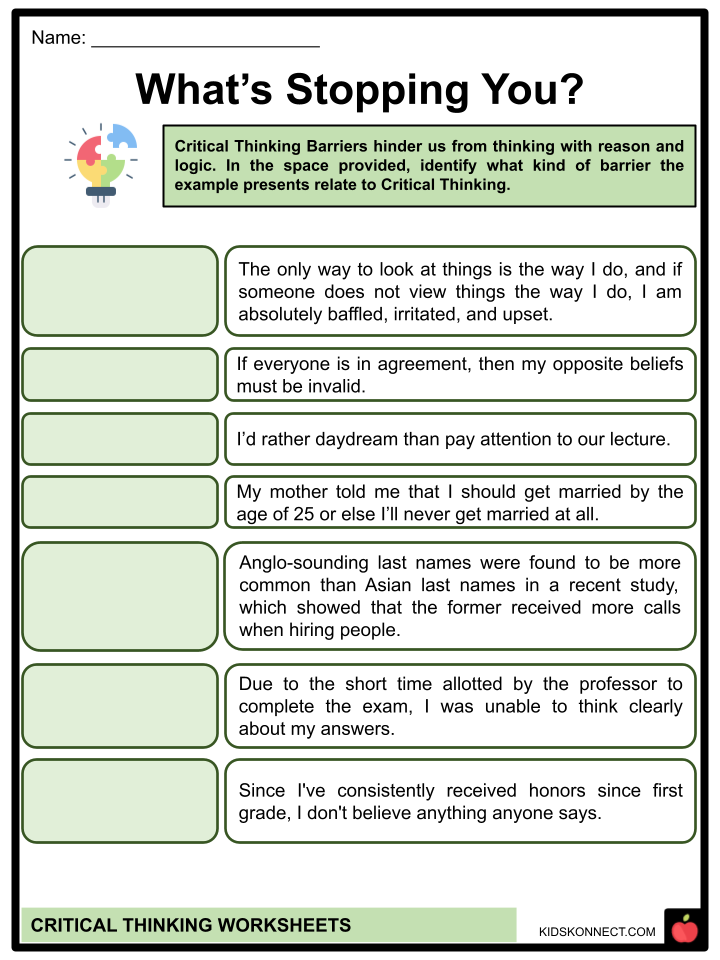
Complete List of Included Worksheets
Below is a list of all the worksheets included in this document.
- Critical Thinking Facts
- What’s Stopping You?
- Life is Full of Premises
- Fact or Opinion
- Rebus Puzzle
- Think It Right
- Connect Me if You Can
- RCA Process
- 5 Whys: Part 1
- 5 Whys: Part 2
- Under the Microscope
Link/cite this page
If you reference any of the content on this page on your own website, please use the code below to cite this page as the original source.
Link will appear as Critical Thinking Facts & Worksheets: https://kidskonnect.com - KidsKonnect, November 24, 2022
Use With Any Curriculum
These worksheets have been specifically designed for use with any international curriculum. You can use these worksheets as-is, or edit them using Google Slides to make them more specific to your own student ability levels and curriculum standards.
Related Resources
KidsKonnect is a growing library of high-quality, printable worksheets for teachers and homeschoolers.
Home Facts Privacy About Blog Contact Terms
Safe & Secure
We pride ourselves on being a safe website for both teachers and students. KidsKonnect uses a secure SSL connection to encrypt your data and we only work with trusted payment processors Stripe and PayPal.
85 Fun Critical Thinking Questions for Kids & Teens

Have you ever thought about using fun questions to practice critical thinking?
Students may need a little guidance to think their way through questions that lack straightforward answers.
But it is that process that is important!
How the Right Questions Encourage Critical Thinking
Every parent knows how natural it is for children to ask questions.
It should be encouraged. After all, asking questions helps with critical thinking.
As they grow older, however, training them to answer questions can be equally beneficial.
Posing questions that encourage kids to analyze, compare, and evaluate information can help them develop their ability to think critically about tough topics in the future.
Of course, critical thinking questions for kids need to be age-appropriate—even better if you can mix a little fun into it!
That’s what I hope to help you with today. I’ve organized the questions below into three different ages groups:
- Upper elementary
- Middle school
- High school

Get a Question-Based Critical Thinking Exercise—Free!
Introduce critical thinking gently & easily with thought-provoking exercises.
Upper Elementary
Students in upper elementary grades can be reluctant to put themselves out there, especially with answers that seem weird.
In some cases, such hesitancy is actually fear of differing from their peers (and a barrier to critical thinking ).
But that’s exactly why it’s important to practice answering ambiguous questions.
We want our children to stand firm for their beliefs—not cave to peer pressure.
Additionally, students may feel uneasy about answering serious questions, uncertain of tackling “big” problems.
However, with careful use of creative questions for kids, it’s possible to engage even the most reluctant children in this age group.
The idea is to simply get them interested in the conversation and questions asked.
If you have an especially reserved student, try starting with the funny critical thinking questions.
Humor is a natural icebreaker that can make critical thinking questions more lighthearted and enjoyable.
Of course, most younger kids just like to be silly, so playing upon that can keep them active and engaged.
With that said, here are some great questions to get you started:
1. Someone gives you a penguin. You can’t sell it or give it away. What do you do with it?
2. What would it be like if people could fly?
3. If animals could talk, what question would you ask?
4. If you were ice cream, what kind would you be and why?
5. Do you want to travel back in time? If yes, how far back would you go? If no, why not?
6. What could you invent that would help your family?
7. If you could stay up all night, what would you do?
8. What does the man on the moon do during the day?
9. What makes something weird or normal?
10. Can you describe the tastes “salty” and “sweet” without using those words?
11. What does it feel like to ride a rollercoaster?
12. What makes a joke funny?
13. What two items would you take if you knew you would be stranded on an island and why?
14. Do you have a favorite way of laughing?
15. What noise makes you cringe and cover your ears? Why?
16. If you could be the parent for the day, what would you do?
17. If you could jump into your favorite movie and change the outcome, which one would you pick and why?
18. If you could be invisible for a day, what would you do?
19. What makes a day “perfect”?
20. If you owned a store, what kind of products would you sell?
21. If your parents were your age, would you be friends with them?
22. Would you still like your favorite food if it tasted the same as always, but now had an awful smell?
23. What would you do if you forgot to put your shoes on before leaving home?
24. Who would you be if you were a cartoon character?
25. How many hot dogs do you think you could eat in one sitting?
26. If you could breathe under water, what would you explore?
27. At what age do you think you stop being a kid?
28. If you had springs in your legs, what would you be able to do?
29. Can you describe the color blue to someone if they’re blind?
Middle School
At this point, students start to acquire more complex skills and are able to form their own conclusions based on the information they’re given.
However, we can’t expect deep philosophical debates with 12 and 13 year olds.
That said, as parent-teachers, we can certainly begin using more challenging questions to help them examine and rationalize their thought processes.
Browse the fun critical thinking questions below for students in this age range.
You might be surprised to see how receptive middle school kids can be to such thought-provoking (yet still fun) questions .
30. What would happen if it really did rain cats and dogs?
31. What does it mean to be lucky?
32. If you woke up in the middle of a dream, where would you be?
33. Is it ever okay to lie? Why or why not?
34. If you were solely responsible for creating laws, what one law would you make?
35. What makes a person a good friend?
36. What do you think is the most important skill you can take into adulthood?
37. If you had to give up lunch or dinner, which would you choose? Why?
38. How much money would you need to be considered rich?
39. If you knew you wouldn’t get caught, would you cheat on a test?
40. If you could live anywhere in the world, where would that be?
41. What is your greatest strength? How is that an asset?
42. If you had an opportunity to visit the International Space Station, would you do it?
43. Is it better to keep the peace or speak your mind?
44. Imagine yourself as your favorite animal. How would you spend your day?
45. Would you be friends with someone who didn’t have the same values as you?
46. How much screen time do you think is too much?
47. Can you describe your favorite color without naming it?
48. If you suddenly became blind, would you see things differently?
49. Would you ever go skydiving?
50. Describe the time you were the happiest in your life. Why did this make you happy?
51. If you had a million dollars, what would you do?
52. If you had to move to a new city, would you change how you present yourself to others?
53. What do you need to do in order to be famous?
54. If you could rewrite the ending of your favorite book or movie, what changes would you make?
55. How would you tackle a huge goal?
56. How would you sell ice to an eskimo in Alaska successfully?
57. What makes you unique?
High School
Critical thinking takes on an entirely different role once students reach high school.
At this age, they have a greater sense of right and wrong (and what makes things so) as well as a better understanding of the world’s challenges.
Guiding teens to delve deeper and contemplate such things is an important part of developing their reasoning and critical thinking skills.

Whether it’s fun questions about hypothetical superpowers or tough critical thinking questions about life, older teens typically have what it takes to think their way to a logical conclusion .
Of course, use your discernment as you choose discussion topics, but here are some questions to help get you started:
58. How can you avoid [common problem] in the future?
59. Do you think it’s okay to take a life in order to save 5, 10, 20 or more people?
60. If you could go back and give your younger self advice, what would it be?
61. Is it better to give or receive a gift?
62. How important is it to be financially secure? Why?
63. If it was up to you, what one rule would you change in your family?
64. What would you do if a group of friends wanted to do something that you thought was a bad idea?
65. How do you know that something is a fact rather than an opinion?
66. What would it take to get you to change your mind?
67. What’s the most important thing in your life?
68. If money were of no concern, what job would you choose and why?
69. How do you know if you’re happy?
70. Do you think euthanasia is moral?
71. What is something you can do today that you weren’t able to do a year ago?
72. Is social media a good thing or not?
73. Is it right to keep animals in a zoo?
74. How does your attitude affect your abilities?
75. What would you do if you found out a friend was doing something dangerous?
76. If you could have any superpower, what would it be? Why?
77. What will life on Earth look like in 50 years?
78. Which is more important, ending world hunger or global warming?
79. Is it a good idea to lower the voting age to 16? Why or why not?
80. If the electrical power went out today, how would you cook if using wood wasn’t an option?
81. If you could magically transport yourself to any other place, where would that be and why?
82. When should teenagers be able to stay out all night?
83. Does the number zero actually exist?
84. What defines a generous person?
85. Does an influential person influence everyone?
Feel free to print out these fun critical thinking questions and incorporate them into your homeschool week!

will your children recognize truth?
About the author.
Jordan Mitchell
- Rating Count
- Price (Ascending)
- Price (Descending)
- Most Recent
Free 10th grade critical thinking worksheets
Resource type.
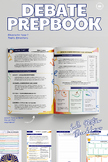
Debate Workbook for Elementary Debaters 8 Weeks of Content
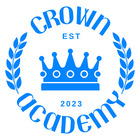
Winning At The Money Game: Student Workbook - Financial Literacy 3rd-12th grade

Word Search Puzzle

Word Search Mini Escape Room Puzzle Game Pack - No Prep Easel Activity Freebie

What's Your Learning Style- Student Quiz/Worksheet with Results

Points, Lines, Planes, and Angles: Always, Sometimes, or Never (FREE)

FREE Biology Bell Ringers and Warm Ups Sample Pack
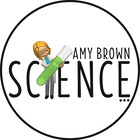
Easy Sudoku Puzzle Freebie Starter Bundle No Prep Worksheet

Speak Think Understand - KWL Chart

Brain Benders - Riddles and Brain Teasers 2

Percy Jackson & the Olympians: The Lightning Thief Movie Viewing Guide (PG-2010)
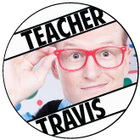
Ted Talk Viewing Worksheet

TED Talk Questionnaire

Logical Fallacies Exercises

Math Maze Fun Worksheet - Free

INTERNATIONAL DOT DAY | FREEBIE 9 Dot Puzzle | The Dot by Peter Reynolds

Free Halloween Activity Frankenstein (1931) Movie Guide | Questions | Worksheet

Four Seasons Sudoku Worksheets Freebie - Four Different Levels

S.M.A.R.T. Goals

Presidents' Day Activity | Quote Cryptogram Code Breaker 2024 FREEBIE

FREE Sample: Flowers for Algernon: Student Reading and Writing Packet
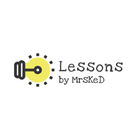
Logical Fallacies Worksheets Definitions and Slideshow TOK IB

Circle Polar Labyrinth Mazes
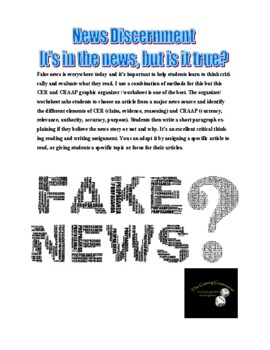
CER and CRAAP News Discernment Investigation: Is It Real or Fake News?

End of Year Reflection Worksheet

Bell Work / Warm-Up Templates

CNN 10 Daily Daily News Worksheet Current Event Graphic Organizer

- We're hiring
- Help & FAQ
- Privacy policy
- Student privacy
- Terms of service
- Tell us what you think
Educationise
11 Activities That Promote Critical Thinking In The Class
Ignite your child’s curiosity with our exclusive “Learning Adventures Activity Workbook for Kids” a perfect blend of education and adventure!
Critical thinking activities encourage individuals to analyze, evaluate, and synthesize information to develop informed opinions and make reasoned decisions. Engaging in such exercises cultivates intellectual agility, fostering a deeper understanding of complex issues and honing problem-solving skills for navigating an increasingly intricate world. Through critical thinking, individuals empower themselves to challenge assumptions, uncover biases, and constructively contribute to discourse, thereby enriching both personal growth and societal progress.
Critical thinking serves as the cornerstone of effective problem-solving, enabling individuals to dissect challenges, explore diverse perspectives, and devise innovative solutions grounded in logic and evidence. For engaging problem solving activities, read our article problem solving activities that enhance student’s interest.
52 Critical Thinking Flashcards for Problem Solving
What is Critical Thinking?
Critical thinking is a 21st-century skill that enables a person to think rationally and logically in order to reach a plausible conclusion. A critical thinker assesses facts and figures and data objectively and determines what to believe and what not to believe. Critical thinking skills empower a person to decipher complex problems and make impartial and better decisions based on effective information.
More Articles from Educationise
- 10 Innovative Strategies for Promoting Critical Thinking in the Classroom
- How to Foster Critical Thinking Skills in Students? Creative Strategies and Real-World Examples
- 9 Must-Have AI Tools for Teachers to Create Interactive Learning Materials
- The Future of Education: 8 Predictions for the Next Decade
- The Latest in EdTech: 5 Innovative Tools and Technologies for the Classroom
- 8 Free Math Problem Solving Websites and Applications
Importance of Acquiring Critical Thinking Skills
Critical thinking skills cultivate habits of mind such as strategic thinking, skepticism, discerning fallacy from the facts, asking good questions and probing deep into the issues to find the truth. Acquiring critical thinking skills was never as valuable as it is today because of the prevalence of the modern knowledge economy. Today, information and technology are the driving forces behind the global economy. To keep pace with ever-changing technology and new inventions, one has to be flexible enough to embrace changes swiftly.
Today critical thinking skills are one of the most sought-after skills by the companies. In fact, critical thinking skills are paramount not only for active learning and academic achievement but also for the professional career of the students. The lack of critical thinking skills catalyzes memorization of the topics without a deeper insight, egocentrism, closed-mindedness, reduced student interest in the classroom and not being able to make timely and better decisions.
Benefits of Critical Thinking Skills in Education
Certain strategies are more eloquent than others in teaching students how to think critically. Encouraging critical thinking in the class is indispensable for the learning and growth of the students. In this way, we can raise a generation of innovators and thinkers rather than followers. Some of the benefits offered by thinking critically in the classroom are given below:
- It allows a student to decipher problems and think through the situations in a disciplined and systematic manner
- Through a critical thinking ability, a student can comprehend the logical correlation between distinct ideas
- The student is able to rethink and re-justify his beliefs and ideas based on facts and figures
- Critical thinking skills make the students curious about things around them
- A student who is a critical thinker is creative and always strives to come up with out of the box solutions to intricate problems
Read our article: How to Foster Critical Thinking Skills in Students? Creative Strategies and Real-World Examples
- Critical thinking skills assist in the enhanced student learning experience in the classroom and prepares the students for lifelong learning and success
- The critical thinking process is the foundation of new discoveries and inventions in the world of science and technology
- The ability to think critically allows the students to think intellectually and enhances their presentation skills, hence they can convey their ideas and thoughts in a logical and convincing manner
- Critical thinking skills make students a terrific communicator because they have logical reasons behind their ideas
Critical Thinking Lessons and Activities
11 Activities that Promote Critical Thinking in the Class
We have compiled a list of 11 activities that will facilitate you to promote critical thinking abilities in the students. We have also covered problem solving activities that enhance student’s interest in our another article. Click here to read it.
1. Worst Case Scenario
Divide students into teams and introduce each team with a hypothetical challenging scenario. Allocate minimum resources and time to each team and ask them to reach a viable conclusion using those resources. The scenarios can include situations like stranded on an island or stuck in a forest. Students will come up with creative solutions to come out from the imaginary problematic situation they are encountering. Besides encouraging students to think critically, this activity will enhance teamwork, communication and problem-solving skills of the students.
Read our article: 10 Innovative Strategies for Promoting Critical Thinking in the Classroom
2. If You Build It
It is a very flexible game that allows students to think creatively. To start this activity, divide students into groups. Give each group a limited amount of resources such as pipe cleaners, blocks, and marshmallows etc. Every group is supposed to use these resources and construct a certain item such as building, tower or a bridge in a limited time. You can use a variety of materials in the classroom to challenge the students. This activity is helpful in promoting teamwork and creative skills among the students.
It is also one of the classics which can be used in the classroom to encourage critical thinking. Print pictures of objects, animals or concepts and start by telling a unique story about the printed picture. The next student is supposed to continue the story and pass the picture to the other student and so on.
4. Keeping it Real
In this activity, you can ask students to identify a real-world problem in their schools, community or city. After the problem is recognized, students should work in teams to come up with the best possible outcome of that problem.
5. Save the Egg
Make groups of three or four in the class. Ask them to drop an egg from a certain height and think of creative ideas to save the egg from breaking. Students can come up with diverse ideas to conserve the egg like a soft-landing material or any other device. Remember that this activity can get chaotic, so select the area in the school that can be cleaned easily afterward and where there are no chances of damaging the school property.
6. Start a Debate
In this activity, the teacher can act as a facilitator and spark an interesting conversation in the class on any given topic. Give a small introductory speech on an open-ended topic. The topic can be related to current affairs, technological development or a new discovery in the field of science. Encourage students to participate in the debate by expressing their views and ideas on the topic. Conclude the debate with a viable solution or fresh ideas generated during the activity through brainstorming.
7. Create and Invent
This project-based learning activity is best for teaching in the engineering class. Divide students into groups. Present a problem to the students and ask them to build a model or simulate a product using computer animations or graphics that will solve the problem. After students are done with building models, each group is supposed to explain their proposed product to the rest of the class. The primary objective of this activity is to promote creative thinking and problem-solving skills among the students.
8. Select from Alternatives
This activity can be used in computer science, engineering or any of the STEM (Science, Technology, Engineering, Mathematics) classes. Introduce a variety of alternatives such as different formulas for solving the same problem, different computer codes, product designs or distinct explanations of the same topic.
Form groups in the class and ask them to select the best alternative. Each group will then explain its chosen alternative to the rest of the class with reasonable justification of its preference. During the process, the rest of the class can participate by asking questions from the group. This activity is very helpful in nurturing logical thinking and analytical skills among the students.
9. Reading and Critiquing
Present an article from a journal related to any topic that you are teaching. Ask the students to read the article critically and evaluate strengths and weaknesses in the article. Students can write about what they think about the article, any misleading statement or biases of the author and critique it by using their own judgments.
In this way, students can challenge the fallacies and rationality of judgments in the article. Hence, they can use their own thinking to come up with novel ideas pertaining to the topic.
10. Think Pair Share
In this activity, students will come up with their own questions. Make pairs or groups in the class and ask the students to discuss the questions together. The activity will be useful if the teacher gives students a topic on which the question should be based.
For example, if the teacher is teaching biology, the questions of the students can be based on reverse osmosis, human heart, respiratory system and so on. This activity drives student engagement and supports higher-order thinking skills among students.
11. Big Paper – Silent Conversation
Silence is a great way to slow down thinking and promote deep reflection on any subject. Present a driving question to the students and divide them into groups. The students will discuss the question with their teammates and brainstorm their ideas on a big paper. After reflection and discussion, students can write their findings in silence. This is a great learning activity for students who are introverts and love to ruminate silently rather than thinking aloud.
Finally, for students with critical thinking, you can go to GS-JJ.co m to customize exclusive rewards, which not only enlivens the classroom, but also promotes the development and training of students for critical thinking.
Share this:
Discover more from educationise.
Subscribe to get the latest posts to your email.
Type your email…
4 thoughts on “ 11 Activities That Promote Critical Thinking In The Class ”
- Pingback: What is Growth Mindset? 50+ Motivational Quotes on Growth Mindset - Educationise
- Pingback: 6 Steps To Implement Project-Based Learning In The Classroom - Educationise
- Pingback: Engaging Problem-Solving Activities That Spark Student Interest - Educationise
Thanks for the great article! Especially with the post-pandemic learning gap, these critical thinking skills are essential! It’s also important to teach them a growth mindset. If you are interested in that, please check out The Teachers’ Blog!
Leave a Reply Cancel reply
Subscribe now to keep reading and get access to the full archive.
Continue reading

- Featured Articles
- Report Card Comments
- Needs Improvement Comments
- Teacher's Lounge
- New Teachers
- Our Bloggers
- Article Library
- Featured Lessons
- Every-Day Edits
- Lesson Library
- Emergency Sub Plans
- Character Education
- Lesson of the Day
- 5-Minute Lessons
- Learning Games
- Lesson Planning
- Subjects Center
- Teaching Grammar
- Leadership Resources
- Parent Newsletter Resources
- Advice from School Leaders
- Programs, Strategies and Events
- Principal Toolbox
- Administrator's Desk
- Interview Questions
- Professional Learning Communities
- Teachers Observing Teachers
- Tech Lesson Plans
- Science, Math & Reading Games
- Tech in the Classroom
- Web Site Reviews
- Creating a WebQuest
- Digital Citizenship
- All Online PD Courses
- Child Development Courses
- Reading and Writing Courses
- Math & Science Courses
- Classroom Technology Courses
- Spanish in the Classroom Course
- Classroom Management
- Responsive Classroom
- Dr. Ken Shore: Classroom Problem Solver
- A to Z Grant Writing Courses
- Worksheet Library
- Highlights for Children
- Venn Diagram Templates
- Reading Games
- Word Search Puzzles
- Math Crossword Puzzles
- Geography A to Z
- Holidays & Special Days
- Internet Scavenger Hunts
- Student Certificates
Newsletter Sign Up
Lesson Plans
- General Archive
- Health & Safety
- Interdisciplinary
- Language Arts
- PE & Sports
- Social Science
- Special Ed & Guidance
- Special Themes
- Top LP Features
- Article Archive
- User Submitted LPs
- Box Cars Math Games
- Every Day Edits
- Five Minute Fillers
- Holiday Lessons
- News for Kids
- ShowBiz Science
- Student Engagers
- Work Sheet Library
- More LP Features
- Calculator Lessons
- Coloring Calendars
- Friday Fun Lessons
- Math Machine
- Month of Fun
- Reading Machine
- Tech Lessons
- Writing Bug
- All Work Sheets
- Critical Thinking Work Sheets
- Animals A to Z
- Backpacktivities
- EveryDay Edits
- Hunt the Fact Monster
- It All Adds Up Math Puzzles
- Make Your Own Work Sheets
- Math Cross Puzzles
- Mystery State
- Math Practice 4 You
- Phonics Word Search Puzzles
- Readers Theater Scripts
- Sudoku Puzzles
- Vocabulous!
- Back to School
- Back to School Archive
- Icebreaker Activities
- Preparing for the First Day
- Ideas for All Year
- The Homework Dilemma
- First Year Teachers
- Don't Forget the Substitute
- More Great Ideas for the New School Year
- Early Childhood
- Best Books for Educators
- Assessments
- Award Certificates
- Bulletin Board Resources
- Classroom Organizers
- Graphic Organizers
- Newsletters
- Parent Teacher Communications
- More Templates
Search form
Worksheet library: critical thinking: grades 3-5.
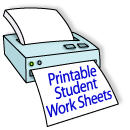
Visit Education World's Worksheet Library for a wide variety of free printables for use across the curriculum and across the grades.
Quotes Solve the math problems to get the letters to a quote. (Grades 3-5)
Jokes Solve the math problems to get the letters to a joke. (Grades 3-5)
The Old House Use math to figure out how to fix the old house. (Grades 3-5)
Balance Algebra Use Algebra to balance the scales. (Grades 3-5)
Balance Benders Given some facts, which objects weight will even off the scales? (Grades 3-5)
Paper Folding Draw how a folded sheet of paper with holes punched in it will look when unfolded. (Grades 3-5)
Analogies With Shapes Which shape completes the analogy? (Grades 3-5)
Penguin Color the thermometer to show the freezing point, then complete the picture of the pengin. (Grades 3-5)
Name That City Read the story. Then make an inference based on the evidence in the story. (Grades 3-5)
Von Bayers Girlfriend Read the true story. Then make an inference based on the evidence in the story. (Grades 3-5)
Whale of a Good Time Read the story. Then make an inference based on the evidence in the story. (Grades 3-5)
Rhyme and Reason Can you figure out the subjects of these simple rhymes? (Grades 3-5)
Rhyme and Reason (#2) Can you figure out the subjects of these simple rhymes? (Grades 3-5)
Rhyme and Reason (#3) Can you figure out the subjects of these simple rhymes? (Grades 3-5)
Rhyme and Reason (#4) Can you figure out the subjects of these simple rhymes? (Grades 3-5)
Rhyme and Reason (#5) Can you figure out the subjects of these simple rhymes? (Grades 3-5)
Rhyme and Reason (#6) Can you figure out the subjects of these simple rhymes? (Grades 3-5)
Antarctica Find 8 errors in this brief article about Antarctica. (Grades 3-5)
The Mystery of the Loch Ness Monster Find 7 errors in this brief article about the Loch Ness monster. (Grades 3-5)
Big Sky Country A friendly letter about Montana helps reinforce letter-writing skills. (Grades 3-5)
Common Nouns Find and write six common nouns found in each picture. (Grades 3-5)
Math Analogies Can you correctly complete each of these math analogies? (Grades 3-5)
Math Analogies (#2) Can you correctly complete each of these math analogies? (Grades 3-5)
The Best Pancake Recipe Find the math answers in this story about Olgas sleepover party. (Grades 3-5)
The Color Spinner Who is most likely to win the Color Spinner game? (Grades 3-5)
Leafy Lengths Complete the graph to show the length of the leaves that Luis and Amy found. (Grades 3-5)
Allowance Graph Answer questions about a graph that show how much allowance five kids get. (Grades 3-5)
Line of Symmetry Which of the six shapes shown on this page are symmetrical? (Grades 3-5)
Find the Nickname These clues will help you figure out each kids nickname. (Grades 3-5)
Order of Age Use the clues to order three kids ages from youngest to oldest. (Grades 3-5)
Lots of Rocks Use the clues to figure out the locations of three rocks. (Grades 3-5)
Theyre in the Band Use the clues to figure out which instrument each kid plays. (Grades 3-5)
Novel Thinking Read the definition. Write the vocabulary word and its part of speech. (Grades 3-5)
Maniac Magee Answer questions with evidence in this excerpt from Maniac Magee by Jerry Spinelli. (Grades 3-5)
The Moon by Night Answer questions with evidence in this excerpt from The Moon by Night by Madeleine LEngle. (Grades 3-5)
Sideways Stories from Wayside School Answer questions about this excerpt from Sideways Stories from Wayside School by Louis Sachar. (Grades 3-5)
Pass the Salt Use evidence from this story to answer the questions about it. (Grades 3-5)
Science Detective: Cells Read the article. Then answer the True/False questions about it. (Grades 4-8)
Science Detective: Change of Phase Use evidence from this article about friction and states of matter to answer the questions. (Grades 4-7)
Scratch Your Brain Use addition and subtraction to figure out solutions to these brain benders. (Grades 3-5)
From One Word to the Next Change a letter in the previous word to make the word that completes each phrase. (Grades 3-5)
Root Words Complete this activity about words that have /capt/ or /tact/ as a root. (Grades 3-5)
Spelling Challenge Circle the word in each group that is correctly spelled. Yes, you can use your dictionary. (Grades 5-8)
Prefixes and Roots Complete this activity about words that have /phone/ as their root. (Grades 3-5)
Education World® Copyright © 2010 Education World
EW Lesson Plans

EW Professional Development
Ew worksheets.







IMAGES
VIDEO
COMMENTS
This arrangement will help you and your students more clearly understand and identify the specific critical-thinking skills they are using. For each thinking skill in this book, there are two kinds of activities: (1) those that you, as the teacher, will lead, and (2) student reproducibles for indepen-dent work.
The activity pages in the Critical Thinking Workbook are meant to be shared and explored. Use it as an electronic document or as worksheets. You can either print off the pages and use them as activity sheets, or you can edit them directly right in the document on your computer.
Critical Thinking Worksheets. Critical thinking is more than just a simple thought process. It involves thinking on a much deeper underlying level rather than just at the surface. There is so much information available to us in this world that we don't know what is true and what is not. That's why it's important for students to analyze, think ...
Fact Families/Missing Addend/Open-Ended Worksheets These worksheets help students develop number sense and critical thinking. You can use the blank sheets to focus lessons on student needs. Both addition/subtraction and multiplication/division are included. Just let me know what I can do to help you use my materials.
100 Ready-to-Print Student Work Sheets Organized by Grade Level. Click on a grade level folder below to find a library of work sheets that you can use with your students to build a wide variety of critical thinking skills. All the work sheets in this library were provided to Education World by our partners at CriticalThinking.com .
About These 15 Worksheets. Critical thinking is the ability to analyze, evaluate, and synthesize information, ideas, and arguments in a thoughtful and systematic manner. These worksheets provide exercises, questions, and prompts that encourage learners to engage in higher-order thinking and develop their abilities to assess, reason, and make ...
Other Critical Thinking Activities. Jigsaw—Developing Community and Disseminating Knowledge: Learners take on the role of "experts" or "specialists" of a particular topic. Then a panel of experts is assembled to get the larger picture. K-W-L Charts—Assessing What We Know/What We Still Want to Learn: Charts to document "What I Know ...
Debates. This is one of those classic critical thinking activities that really prepares kids for the real world. Assign a topic (or let them choose one). Then give kids time to do some research to find good sources that support their point of view. Finally, let the debate begin!
Provides grading rubrics and outlines five levels of close reading and substantive writing. #563m. "Aspiring Thinker's Guide to Critical Thinking" Mini-Guide Price List: (+ shipping and handling) Item #554m. 1-24 copies $6.00 each 25-199 copies $5.00 each 200-499 copies $4.00 each 500+ copies $3.50 each.
Browse free critical thinking resources on Teachers Pay Teachers, a marketplace trusted by millions of teachers for original educational resources. ... Kids Relaxing Printable Sheets. ... but they also get kids to think more deeply about all the things they have to be grateful for. This activity is a good one for Thanksgiving, but could be used ...
Check out these critical thinking activities, adapted from Critical Thinking in the Classroom , a book with over 100 practical tools and strategies for teaching critical thinking in K-12 classrooms. Four Corners. In this activity, students move to a corner of the classroom based on their responses to a question with four answer choices. Once ...
Critical Thinking Worksheets for Kids. Critical Thinking Worksheets are an invaluable educational tool designed to enhance students' critical thinking skills. These worksheets are the perfect platform for students to practice applying logic, reasoning, and evaluation techniques, honing their analytical skills in all subject areas.
It has activities that are adaptable to any grade level you want. The activity pages in the Critical Thinking Workbook are meant to be shared and explored. Use it as an electronic document or as worksheets. You can either print off the pages and use them as activity sheets, or you can edit them directly right in the document on your computer.
Critical Thinking Worksheets. Using the first critical thinking worksheet below, your students will gather evidence about what happened to a missing snack and try to avoid making assumptions. And in the second critical thinking worksheet, students will evaluate facts based on visual information. Just like a detective, students will look at the ...
Exercise #1: The Ladder of Inference. You can exercise your critical thinking skills by using the Ladder of Inference model. This thinking model was developed by renowned organizational psychologist Chris Argyris. Each rung on the ladder of inference represents a step you take to arrive at your conclusions.
Shape Patterns - Cut and Paste - One Worksheet. Spot the difference - Spider - One Worksheet. Spot the difference - Butterfly - One Worksheet. Spot the difference - Bee - One Worksheet. Spot the difference - Owl - One Worksheet. Spot the difference - One Worksheet. Spot the difference - Van - One Worksheet. Spot the ...
Critical thinking is a process of making decisions about what to believe or do based on reasonable and introspective thinking. It relies on exploring relevance, soundness, accuracy, precision, consistency, depth, breadth, and justice. Click for PDF worksheets!
Humor is a natural icebreaker that can make critical thinking questions more lighthearted and enjoyable. Of course, most younger kids just like to be silly, so playing upon that can keep them active and engaged. With that said, here are some great questions to get you started: 1. Someone gives you a penguin.
A fun way to help exercise students' problem-solving, critical thinking, and focusing skills. Great to help keep students busy w. 3 rd - 12 th, Higher Education, Adult Education. Critical Thinking, End of Year, Numbers. FREE. Rated 4.63 out of 5, based on 38 reviews ... This FREE simple 9 Dot Puzzle Activity Sheet can be used for Dot Day on ...
6. Start a Debate. In this activity, the teacher can act as a facilitator and spark an interesting conversation in the class on any given topic. Give a small introductory speech on an open-ended topic. The topic can be related to current affairs, technological development or a new discovery in the field of science.
Yes, you can use your dictionary. (Grades 5-8) Complete this activity about words that have /phone/ as their root. (Grades 3-5) 100 ready-to-print student worksheets for Grades 3-5. Use these worksheets with your students to build a wide variety of critical thinking skills.
Critical thinking, as described by Oxford Languages, is the objective analysis and evaluation of an issue in order to form a judgement. Active and skillful approach, evaluation, assessment, synthesis, and/or evaluation of information obtained from, or made by, observation, knowledge, reflection, acumen or conversation, as a guide to belief and action, requires the critical thinking process ...
Ultimate Critical Thinking Cheat Sheet. Dale Ignatius. 02/24/2023 at 6:28 pm. 02/27/2023 at 9:51 am. Infographic by Global Digital Citizen.